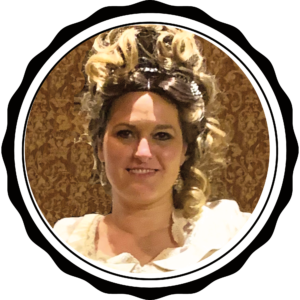
Rebecca Armstrong, Bridal Ensemble for 1881 Tombstone Wedding 2020!

Rebecca found us through the website, wanting to know because she had a short time to prepare for her wedding, if we had anything to rent. Her fiance had said he would be wearing something special, but wouldn’t tell her what, but one could guess it would be Wyatt Earp, since the wedding was to be a theme wedding in Tombstone, Arizona.
Suzi was on the road to a family funeral when she got the call, and made all the communications, sketches, research, and ordering while driving across the US (backwards then forwards on the Oregon Trail). We had just time for one measuring session, and no time for a fitting until the morning before the wedding.
Pressure was on to find materials that fast, get it designed, built, and shipped in her hands by the Friday before the wedding! The real pressure was to get that perfect “body armor” fit of the cuirasse bodice of 1881 without ever having met in person, with one quick measurement session, and 3 photos.
Through it all, Rebecca remained most flexible and accommodating and gracious; understanding when the fabric came gold, and when it had to be shipped to Tombstone directly. She had to trust the fit and the design sight unseen; had never even seen anything but the sketches before she put it on for the first time the day before her wedding. It was a perfect fit!

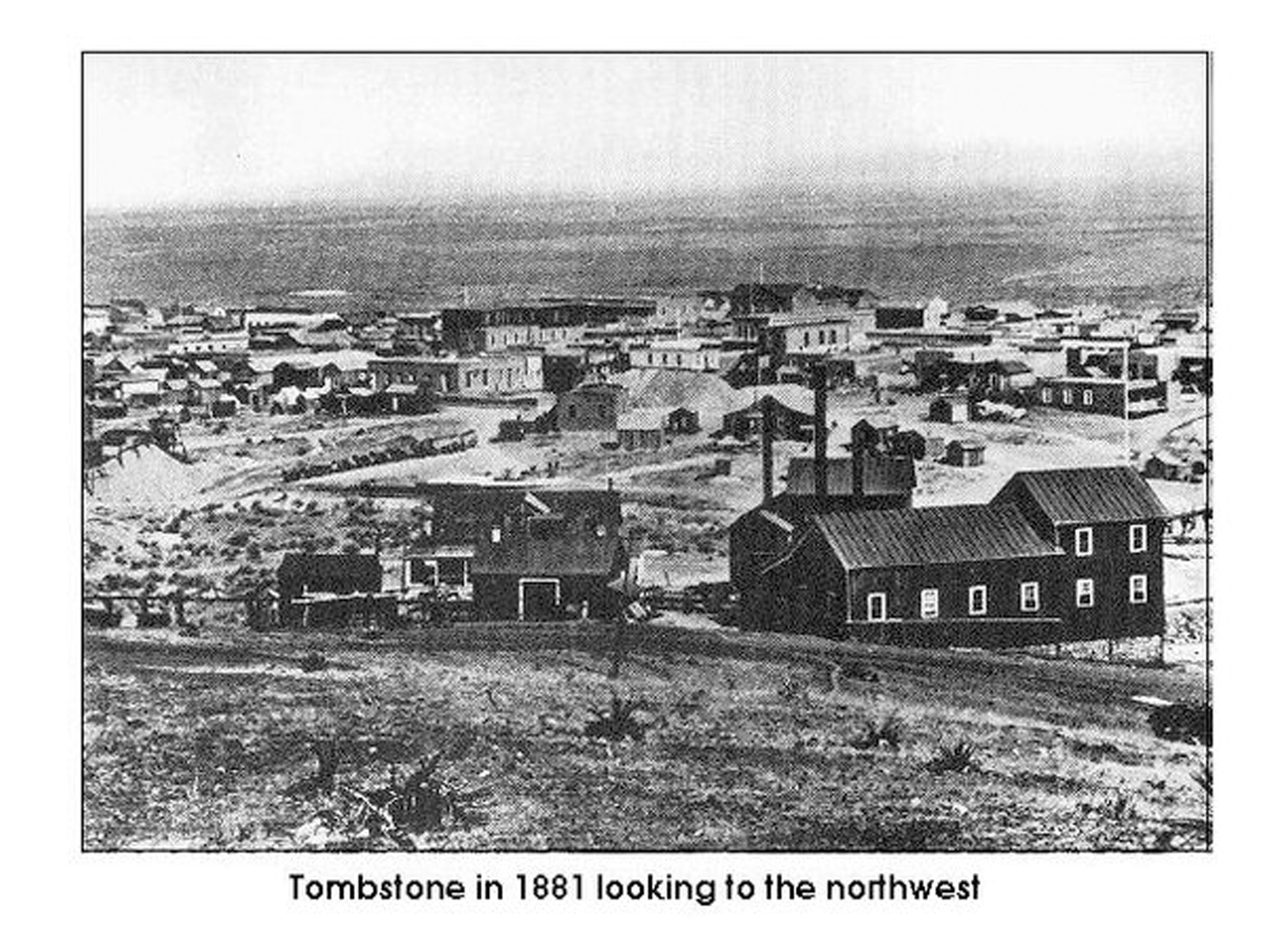
The basis for the character and design was Josephine, Wyatt Earp’s final wife, and based on the costuming in the film. Josephine’s character was rarely shown in full view, and when she was, it was fuzzy in the background. It gave us somewhat of an idea, but we really had to base our design on what we knew about the era.
1870’s or 1880’s?
The primary decision was whether to be absolutely historically accurate: 1 because accurate meant an absolute perfect fit, and 2 because Rebecca really liked the Natural Form look more than the 1881-83 which was starting to have the larger bustle and back side. She decided early on it was “ok” to have elements from that 4-5 year timespan, which gave the “look” she was after.
That “look” was to have a tiny waist and curves, with full breasts and an open bodice. She also wanted the vertical lines of the Natural Form, but with draping and fullness in the back.
She loved butterflies, and built them in to her bouquet which she made herself. When the fabric came a different color, that threw her for the first time in the project, but she recovered.
In the end, we ended up with the gores of an 1876 skirt, shorter bodice towards 1878, apron drape of 1881, and a butterfly train of 1883. We covered it all! The fabric was GORGEOUS, though not at all what either expected. The two pluses of that were that she will be able to wear it for many depictions, plus she says she looks awful in white.
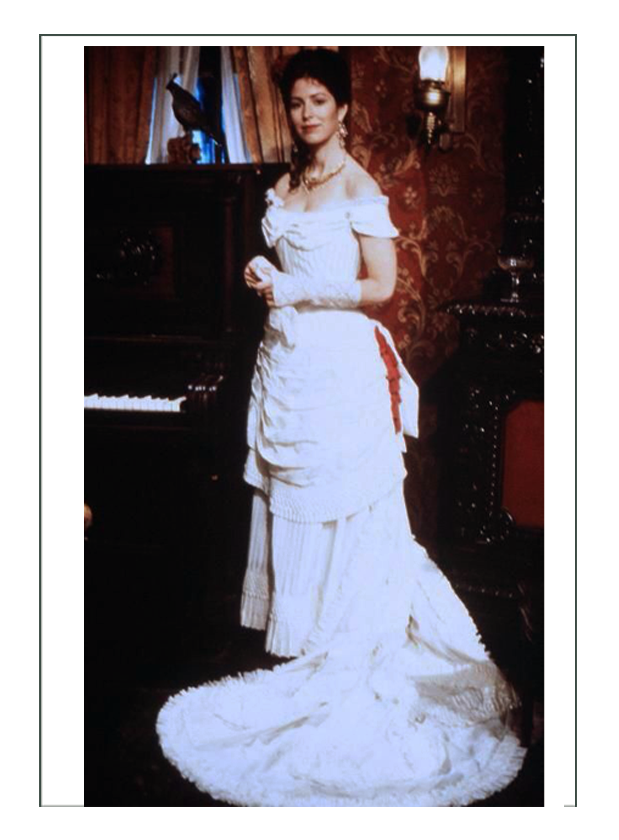
Perfect Fit
All of it except the breast pads which Suzi forgot to put in the overnight package, made it on time, and the fitting, thanks to Rebecca’s knowledgable and experienced friend Stephanie, when beautifully. The secret, of course, was in getting the corset on correctly and pre-set so the outer garments always fit – just like women of history did!
All in all, it was an amazing experience for Suzi to be part of such a special event, and Silhouettes was honored to be able to contribute and to wish all the best in the world to the new family created in Tombstone that day.
Click here to go to Rebecca’s Historical Context page (next)
Click here to go to the Fashion History pages including 1870’s vs 1880’s blog section
Click here to go to the Design Development page with Fabric selection
Continue below to see the Finished Project
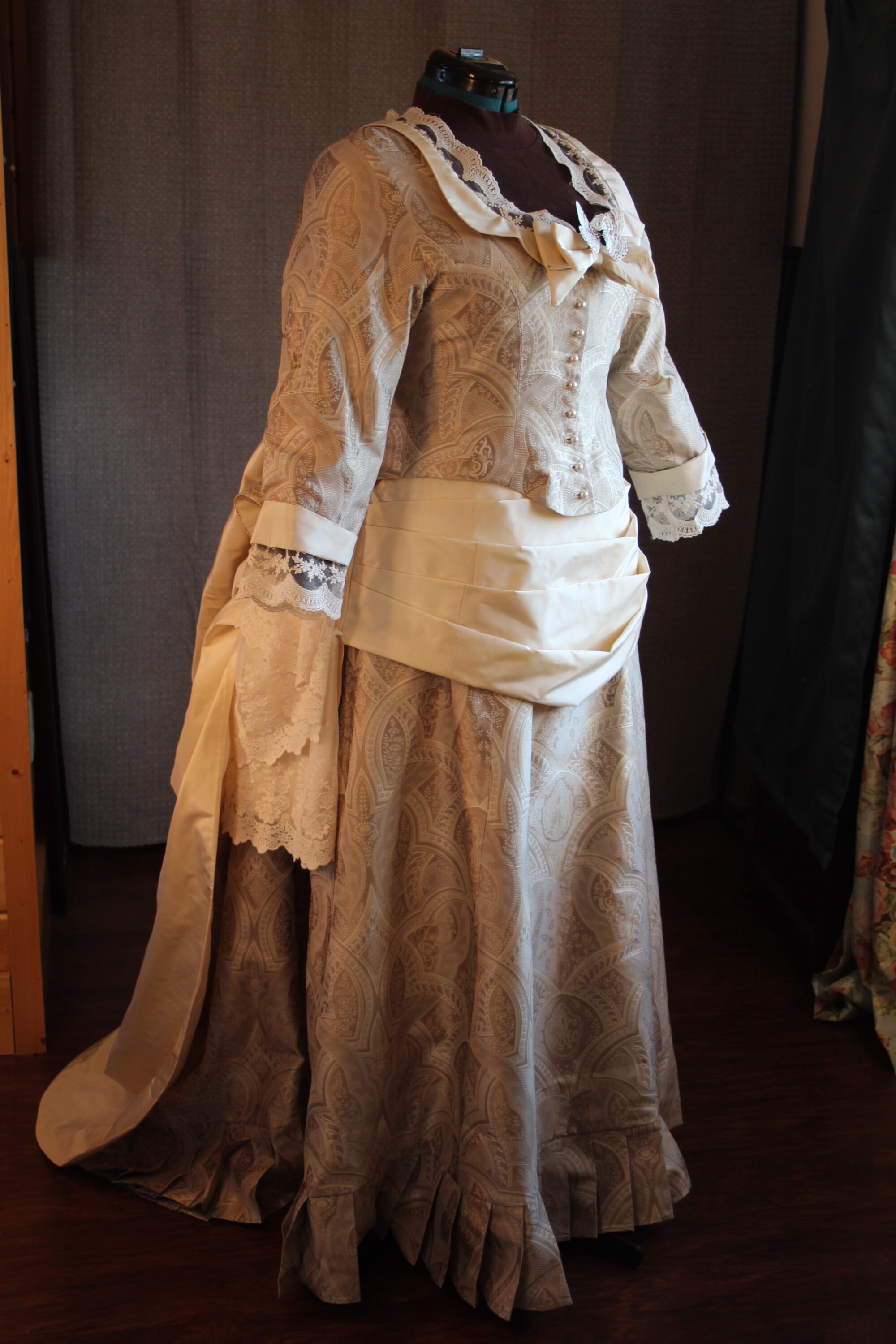

Final Design Sketches
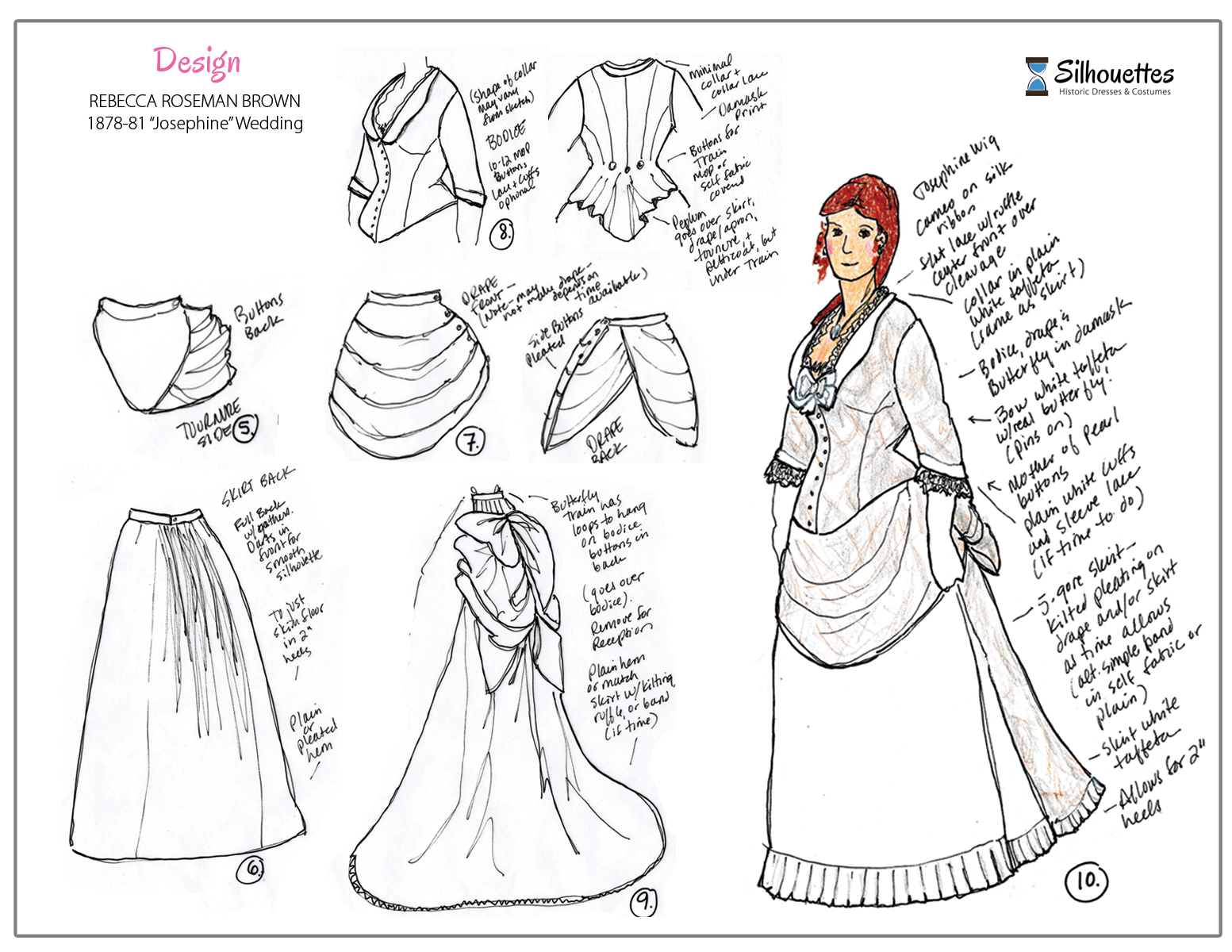
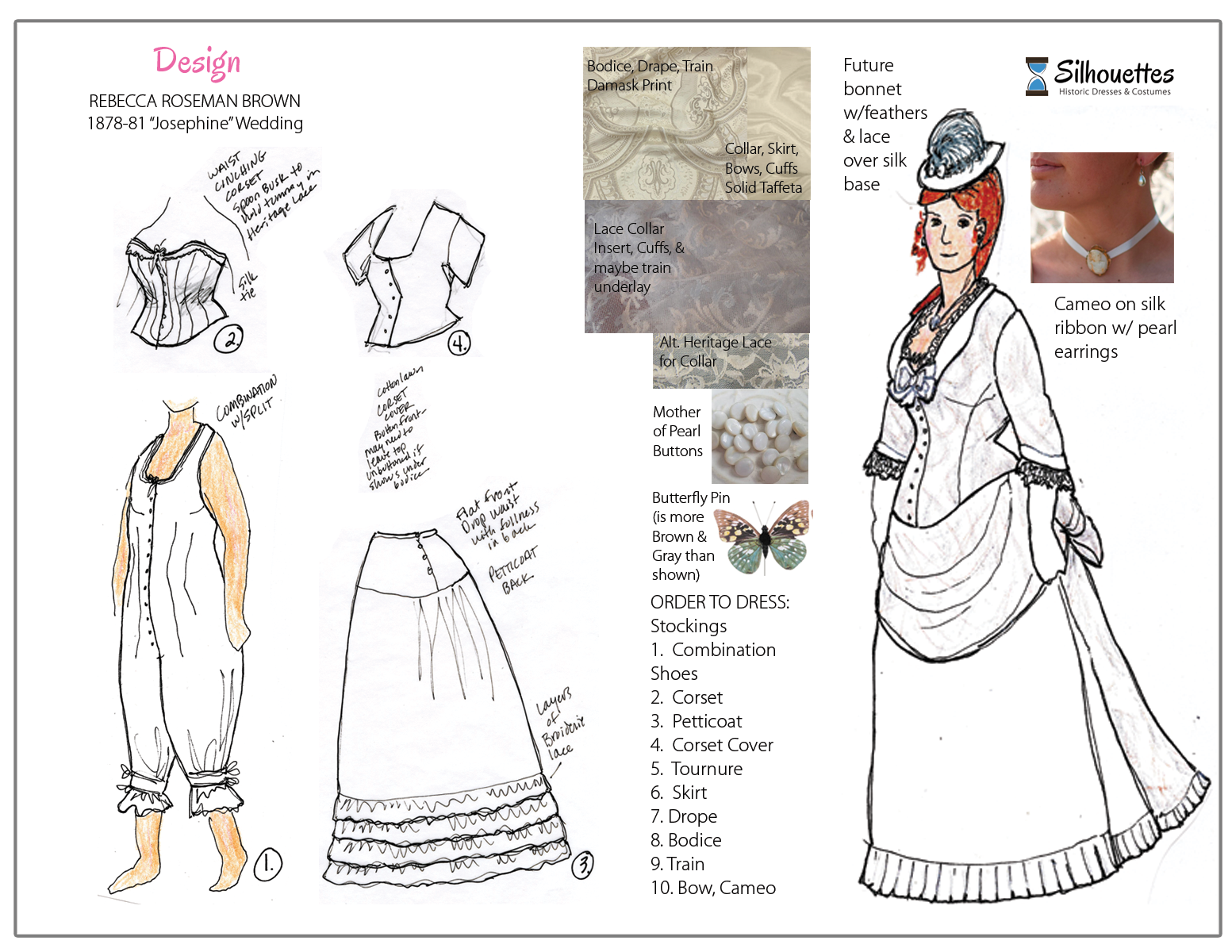

Fabric (sorry no photos of lace alone)
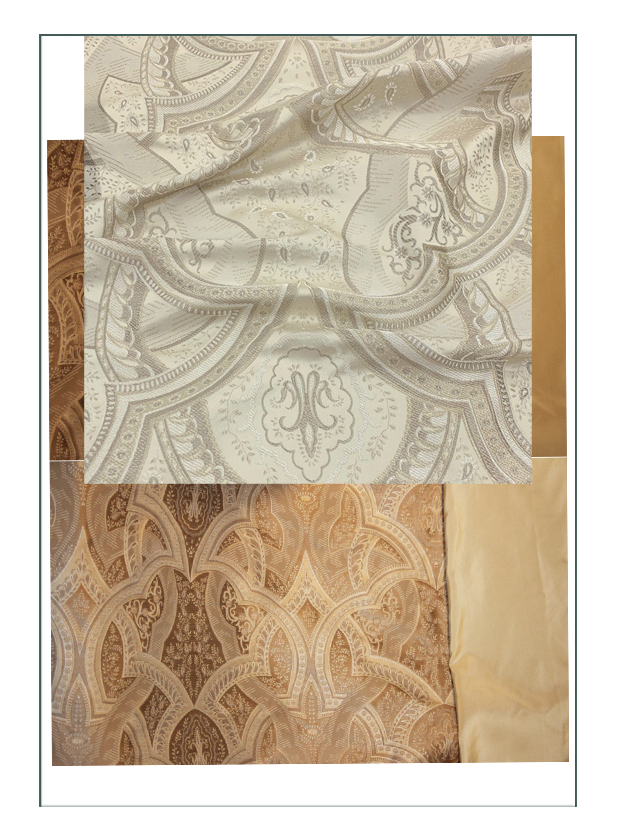

Combination
We had to use a stock item for this, and this was actually a 1905 specific garment but a perfect fit. Color doesn’t matter as long as it doesn’t show in the bodice, and this one didn’t. She has a white one too that the neckline is a bit to high for this ensemble; both gently used. It has a split for use in the “necessary”, and we call this the “clown suit” which should be very baggy though not drooping, so it can be adjustable under the corset, yet not fold or crease enough to cause discomfort. We may make her a custom one in the future, but this one did just fine!
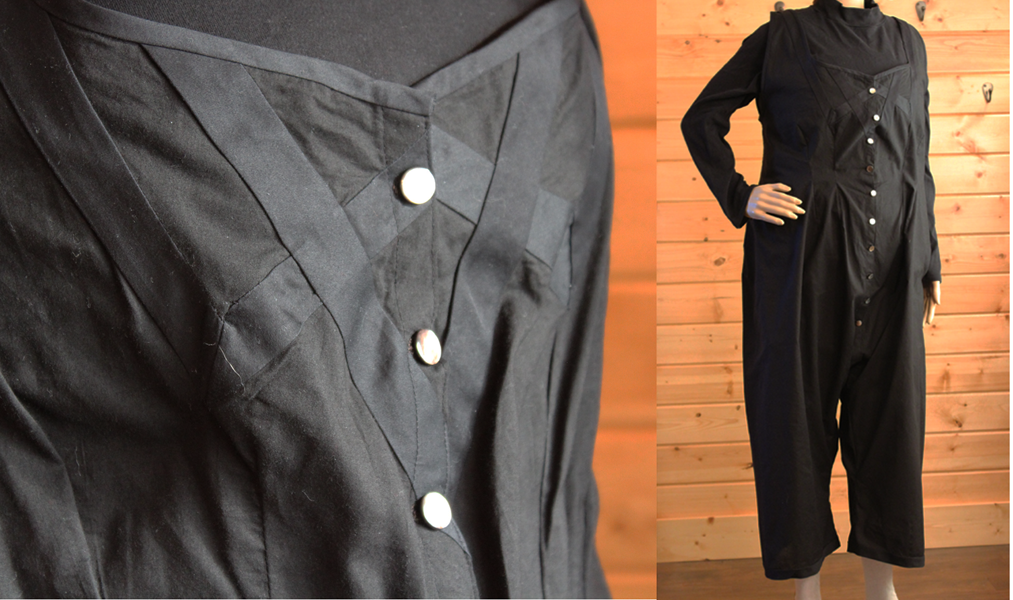
Corset
This corset is made of heavy brocade couteil and is fully lined and heavily boned for tight cinching. It has a silk string tie to bring in the “ridge” which was considered vulgar by the 1880’s. The heavy stainless spoon busk tucks in the tummy so the flat vertical shape of the skirt has no lines and no interruptions. This is a bit shorter than period correct which will expand its interpretations for other projects, but also allows free movement and the ability to sit easily or drive a car, which the later corsets could not do. It is designed for a somewhat short waist and hits about 1″ above the hip bones for ease in hip movement.
Eventually, this should be easy for Rebecca to get into herself using the “rabbit ears” long lacing, which are flagged by a different colored grommet. It has reinforcement waist tapes, so while this project we only brought her in a couple of inches, future projects we can get her a real hourglass shape with a tight waist cinching. Civil War next, Rebecca?
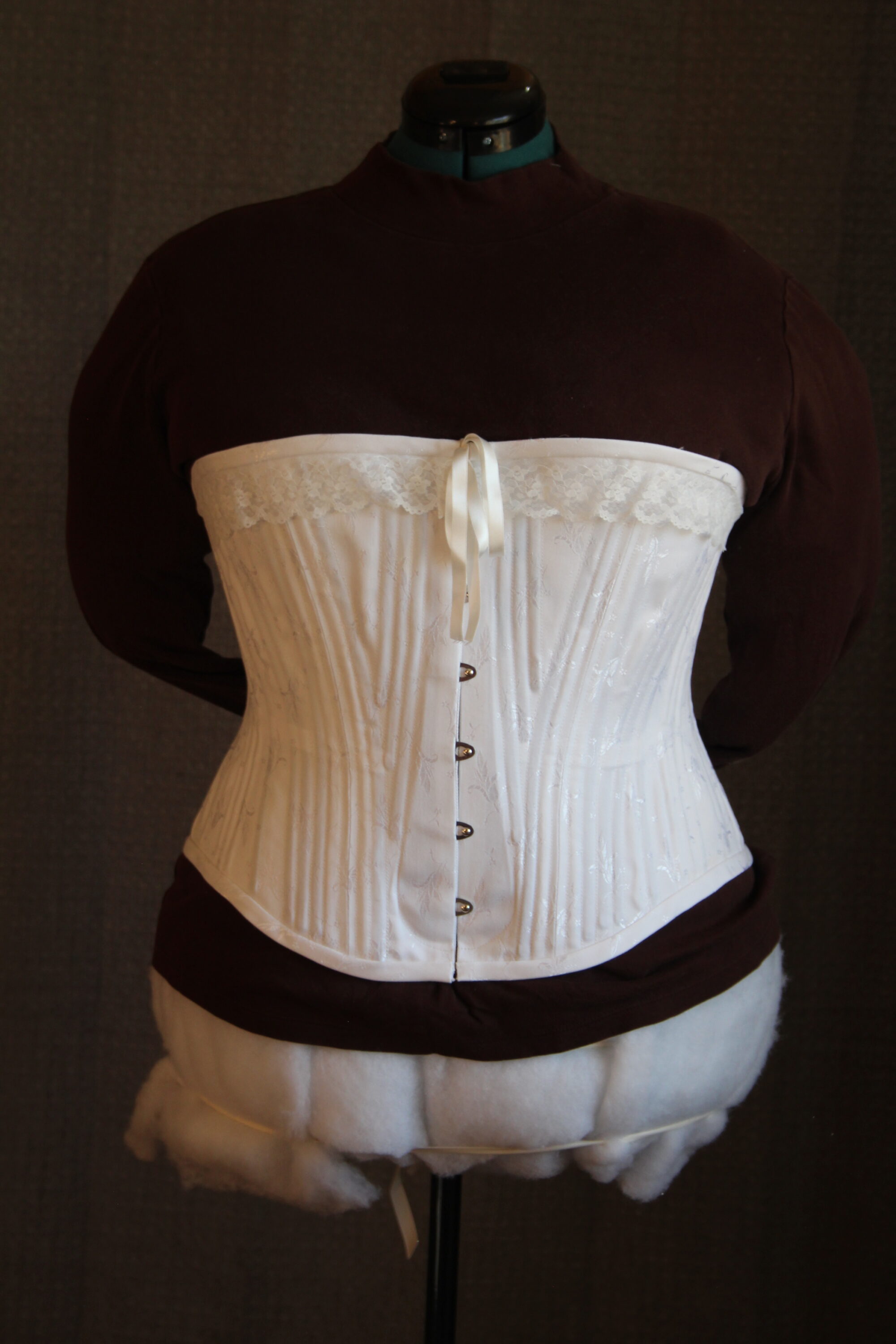
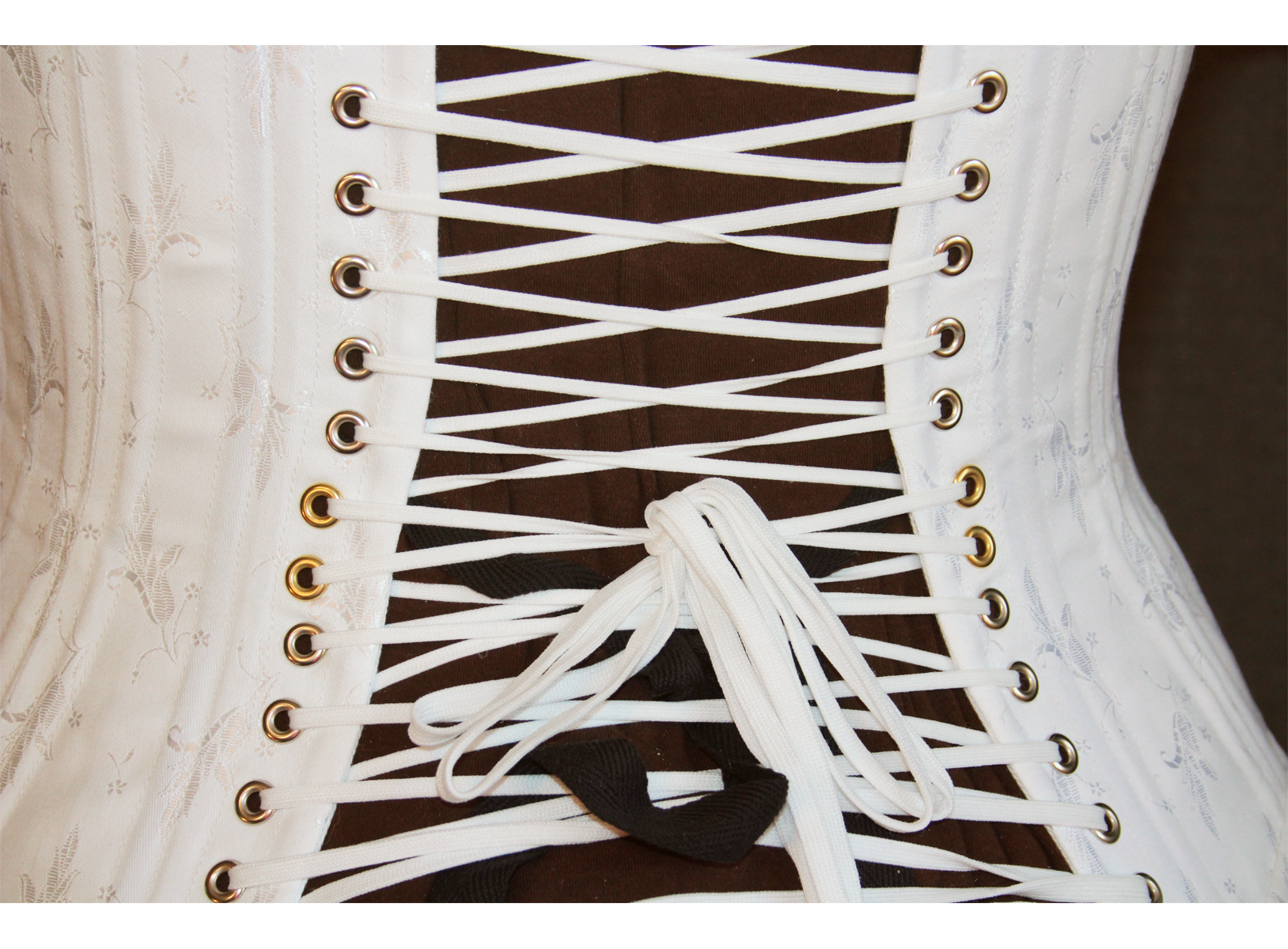
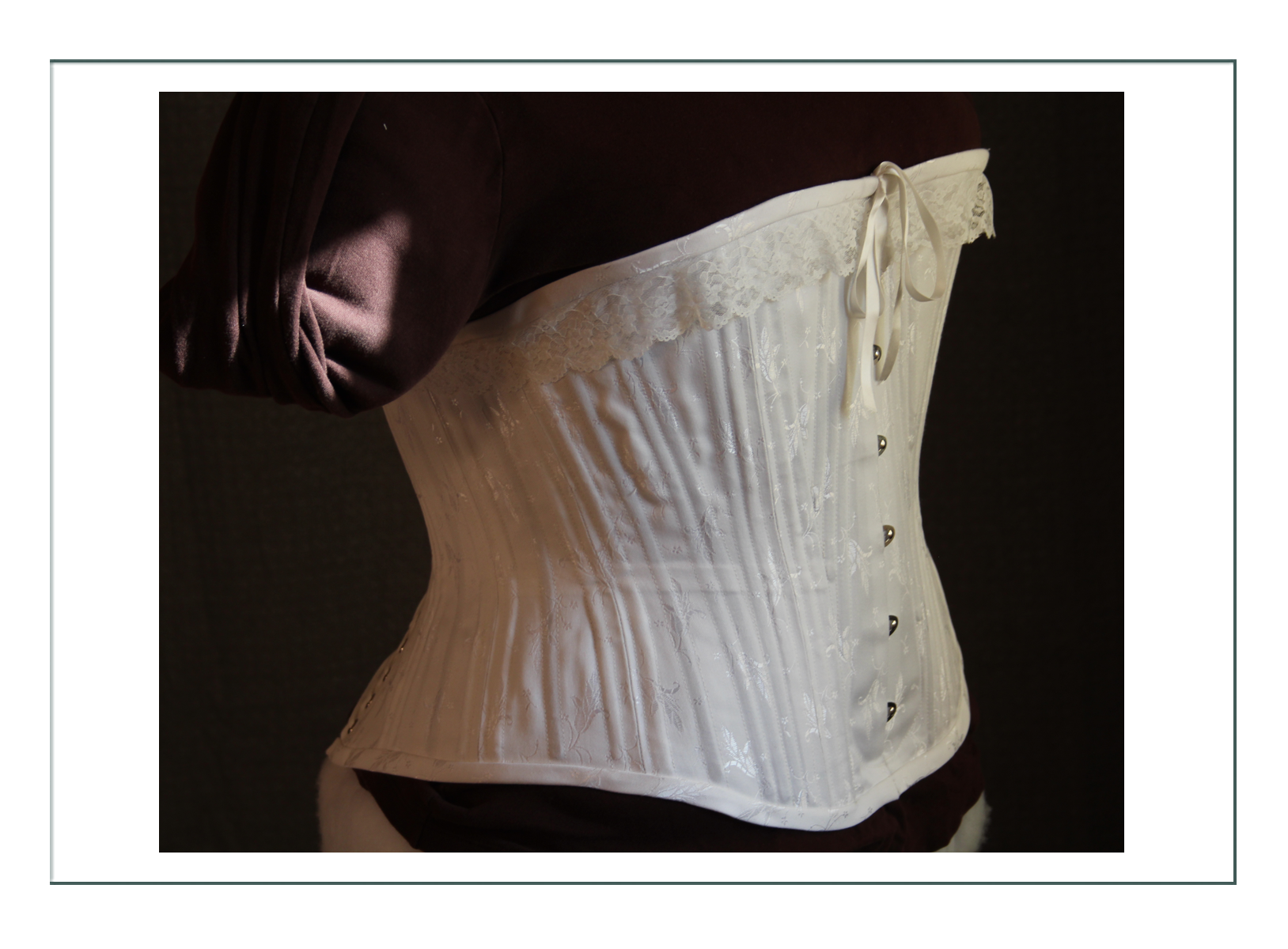
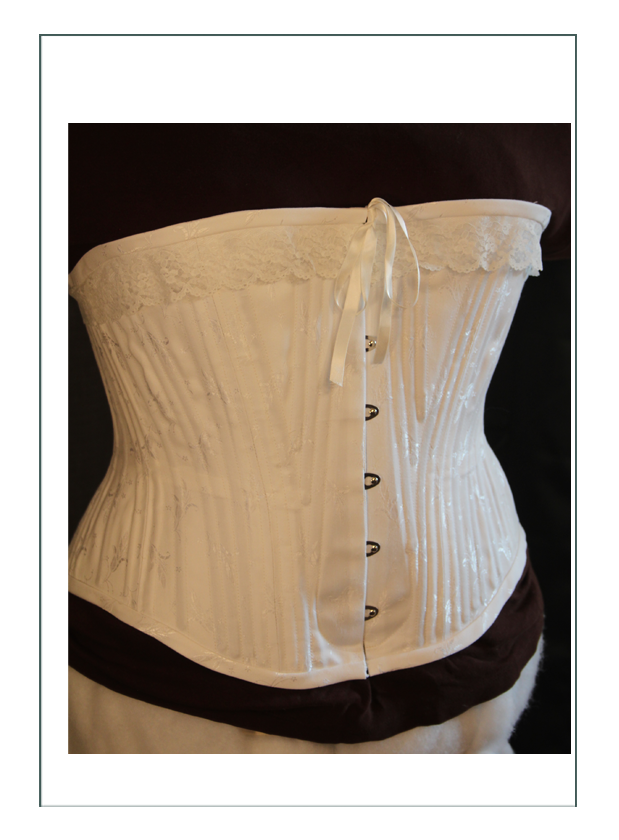
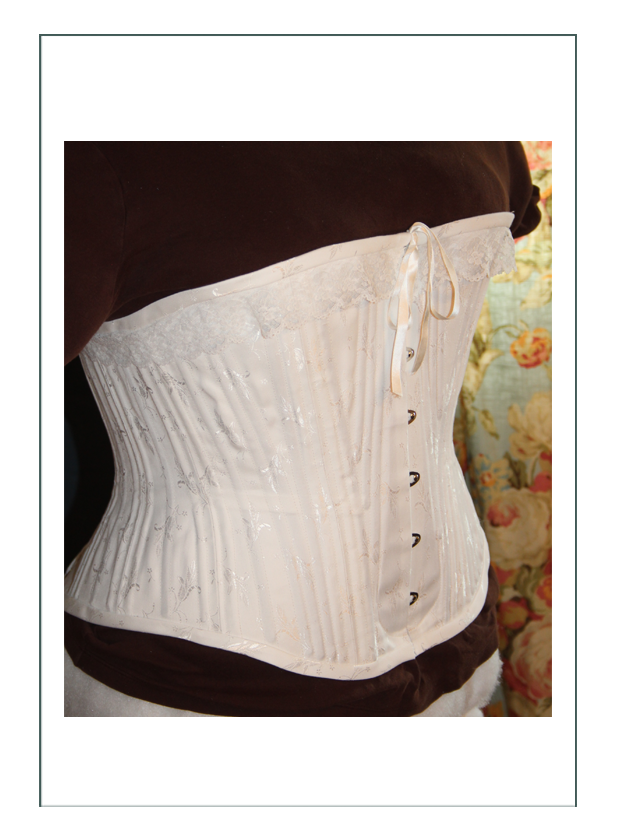
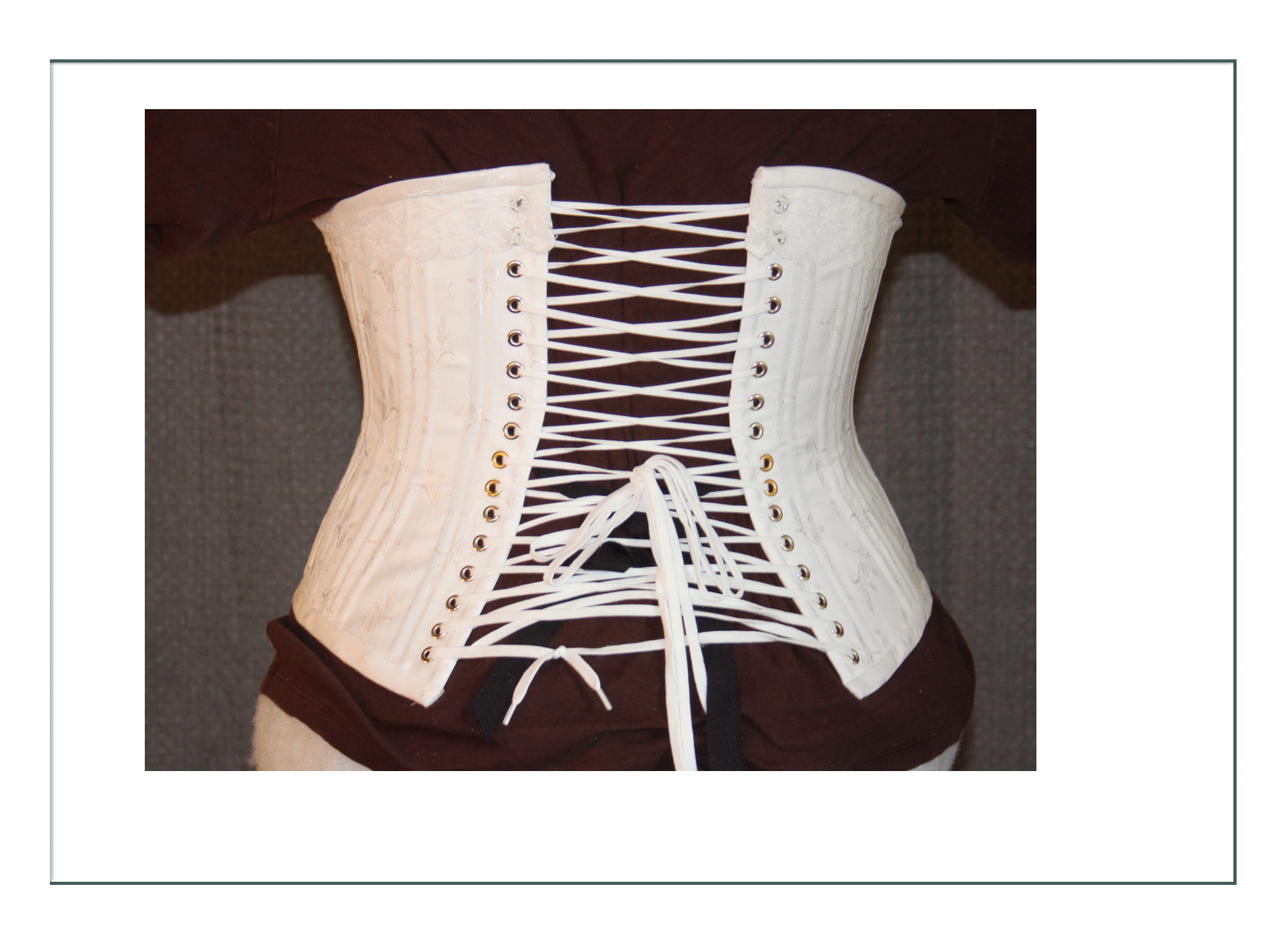
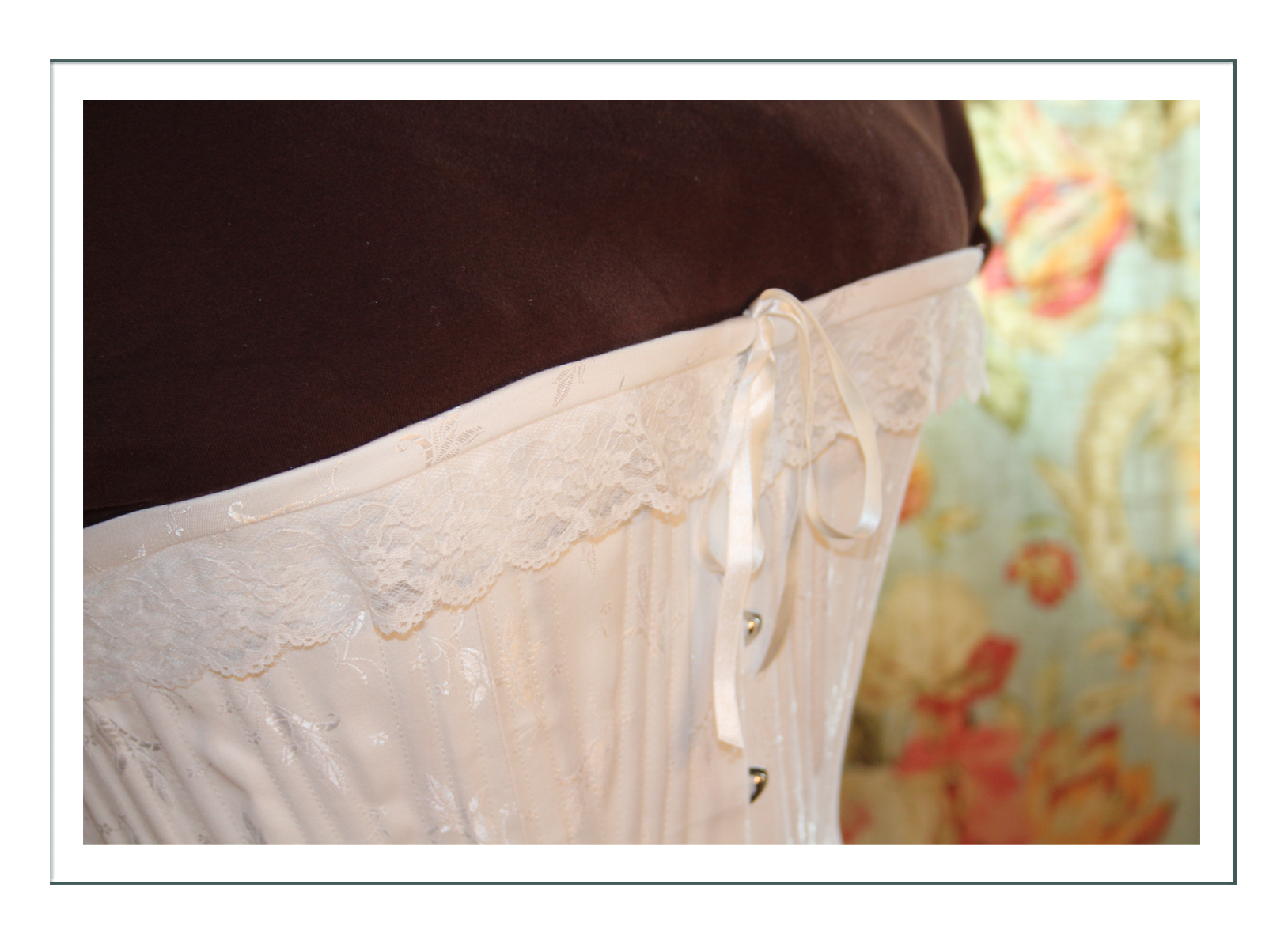
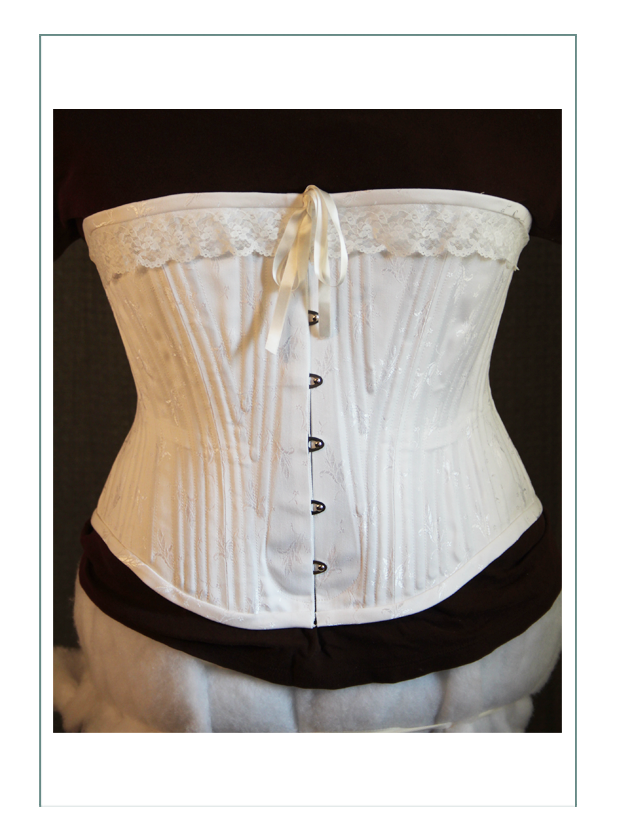
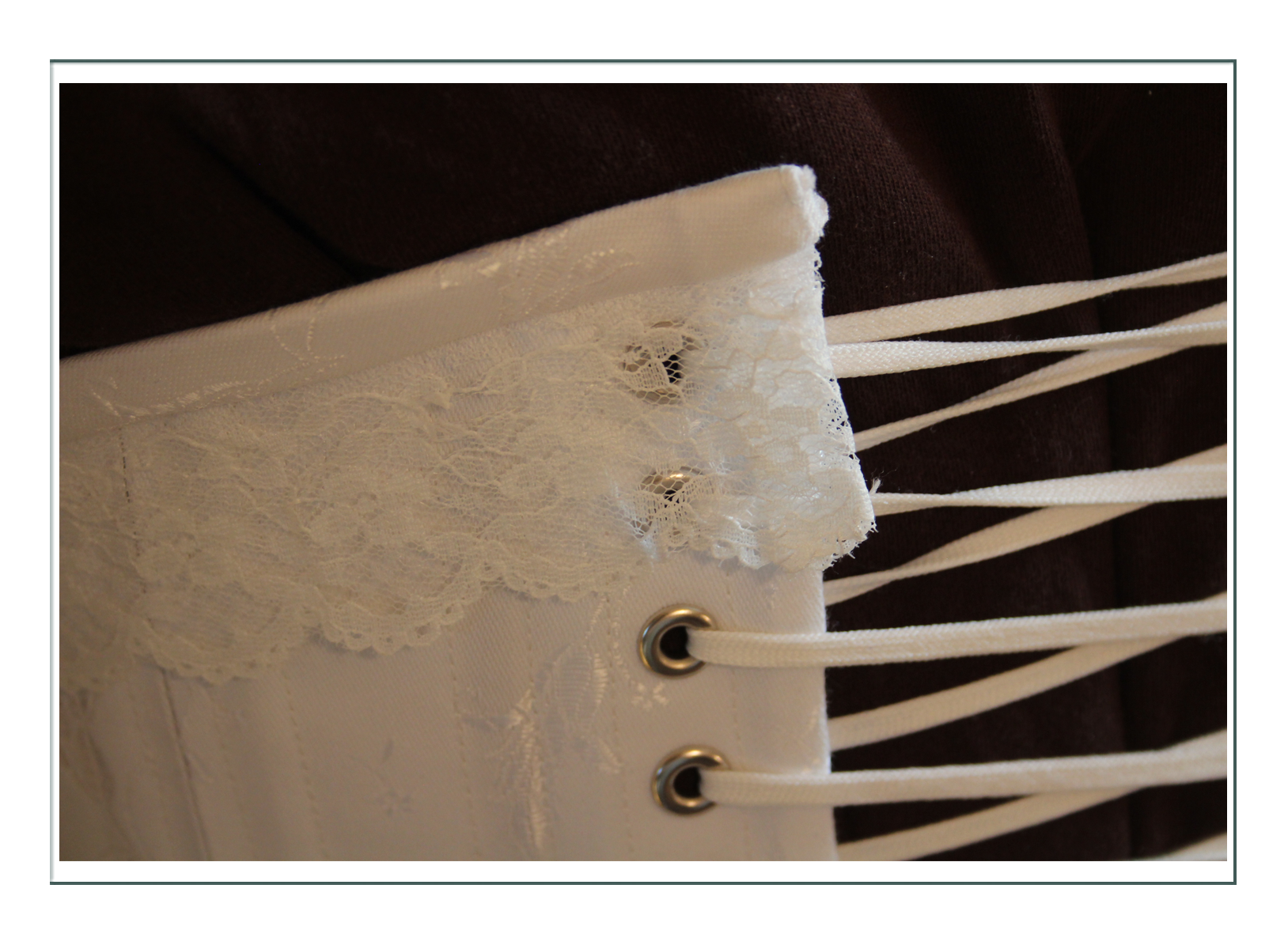
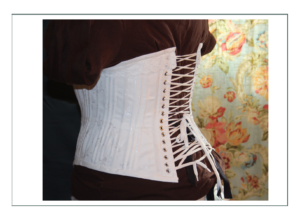
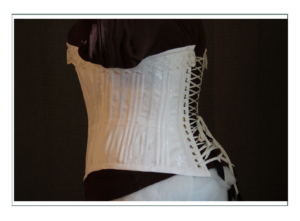
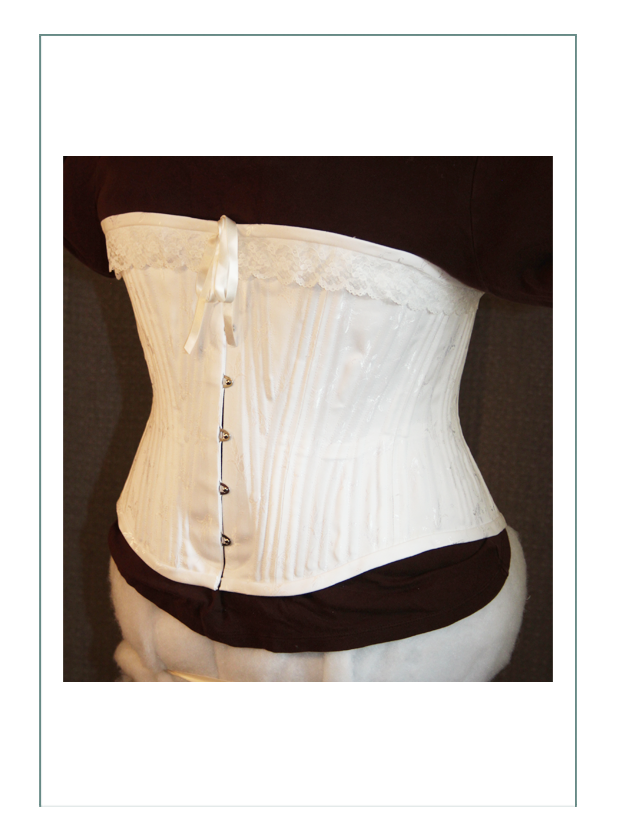
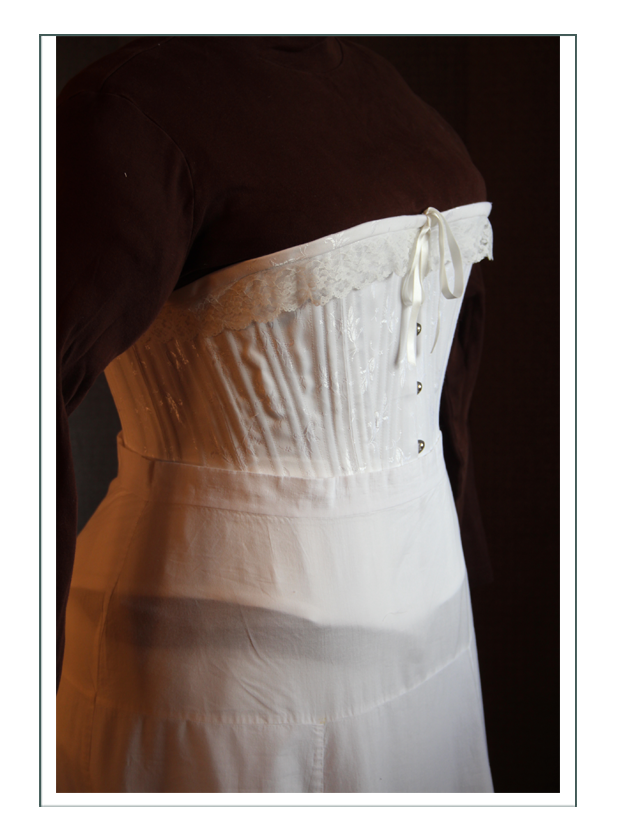
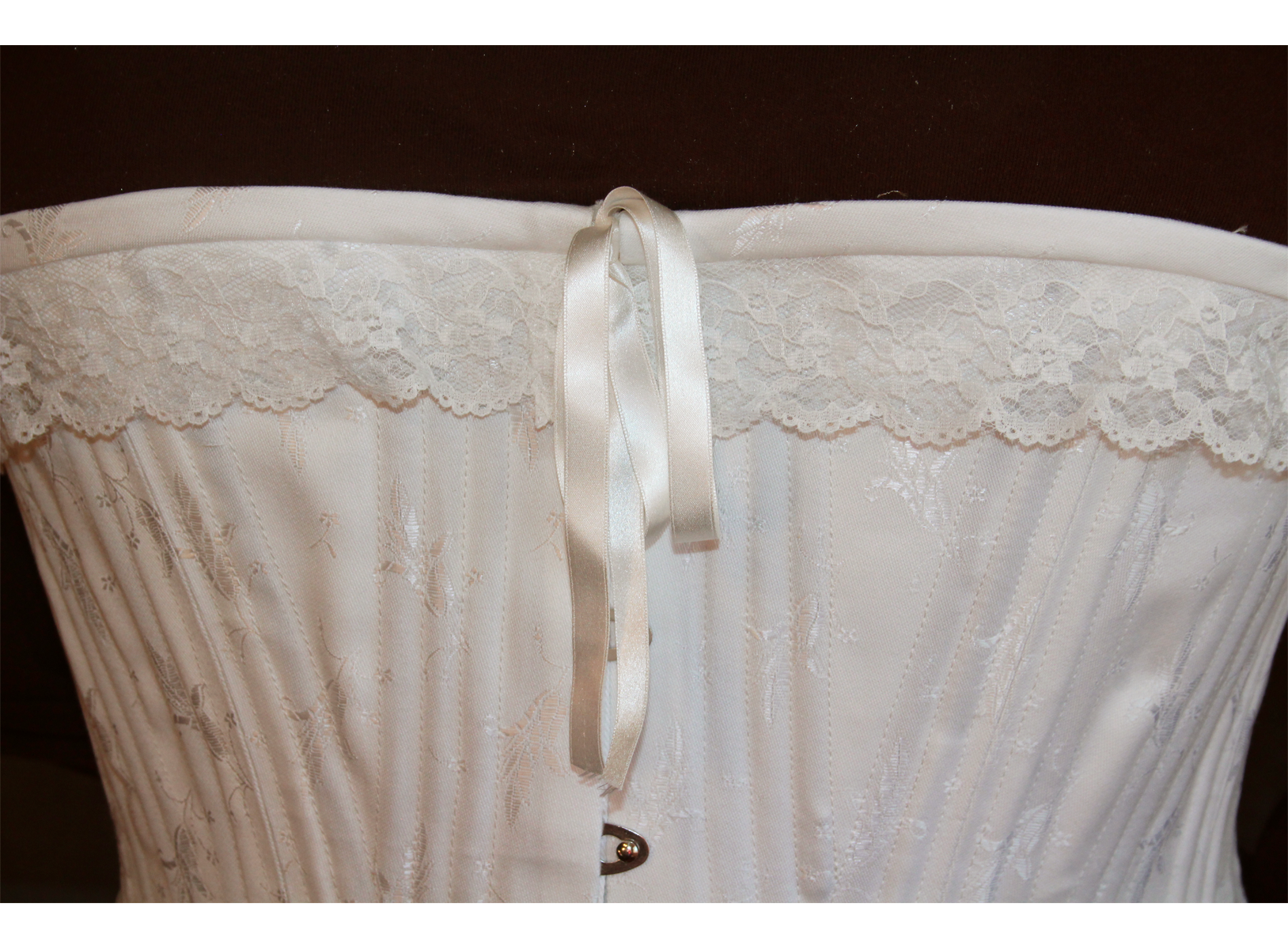
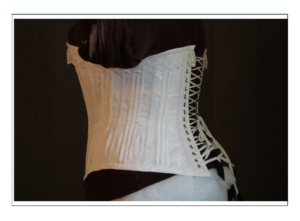
Petticoat
Emulating the shape of the skirt that would go over this, it has a draping cord inside to keep the fabric pulled smooth in front and sides and full in back. 6 layers of cotton broderie lace makes it very special. There are adjustment tucks to accommodate the later gored skirts of the 1890’s if let out. This is cotton lawn, and features mother of pearl buttons high in the back, with gathers in back to augment the shape of the skirt. It’s main purpose, however, is to keep the skirts away from the legs so a woman can walk forward easily “kicking” the lower pleated part of the skirt out despite the somewhat “tubular” shape of the front and sides of the skirt.
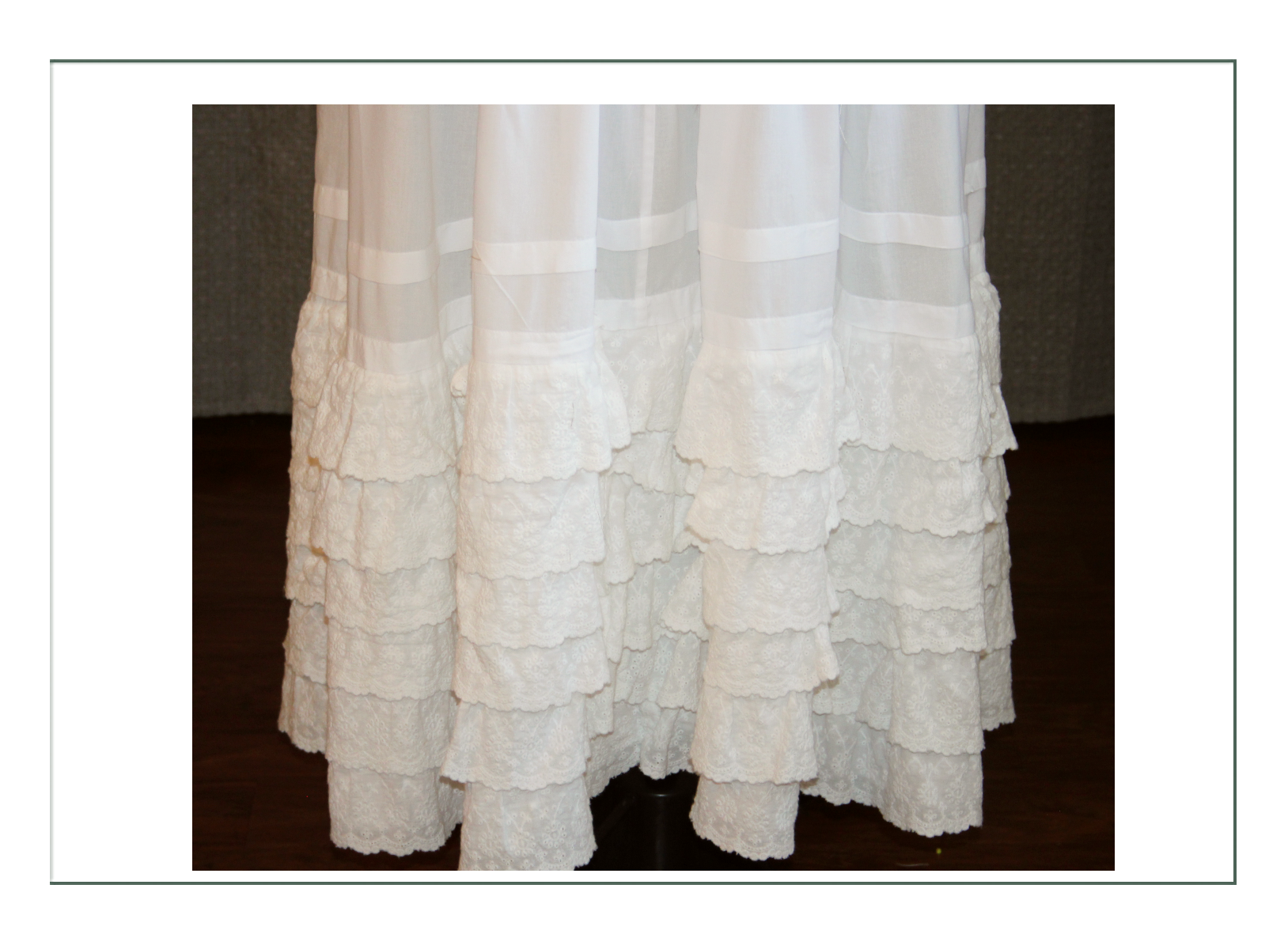
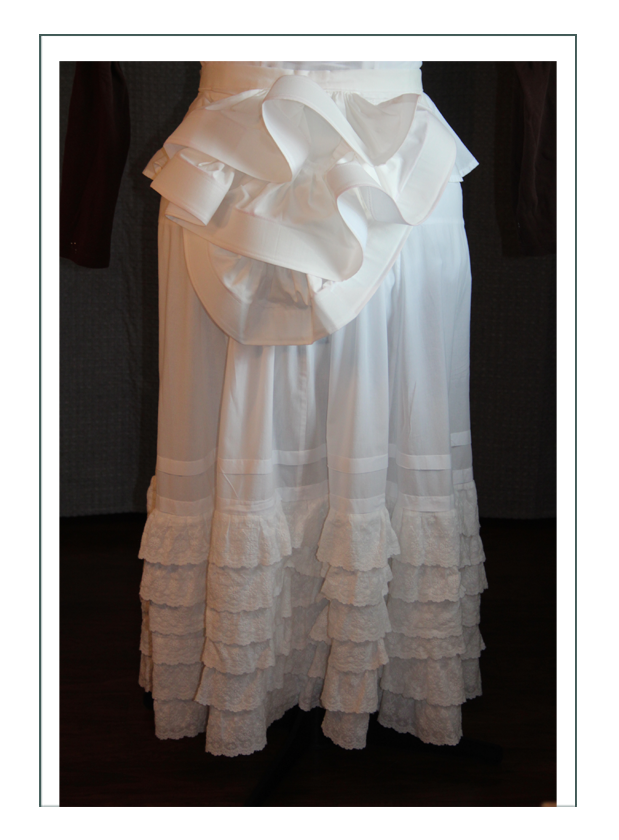
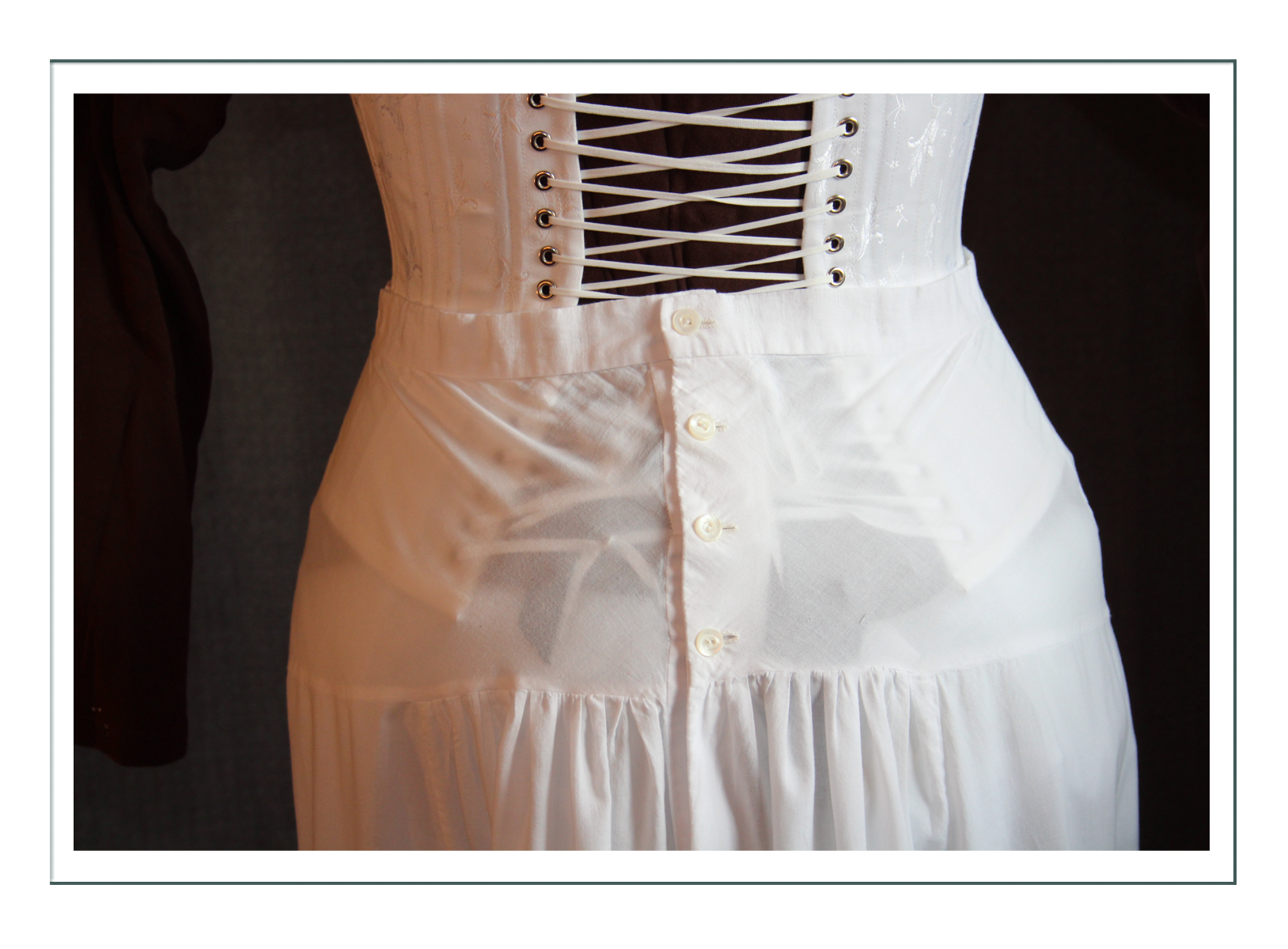
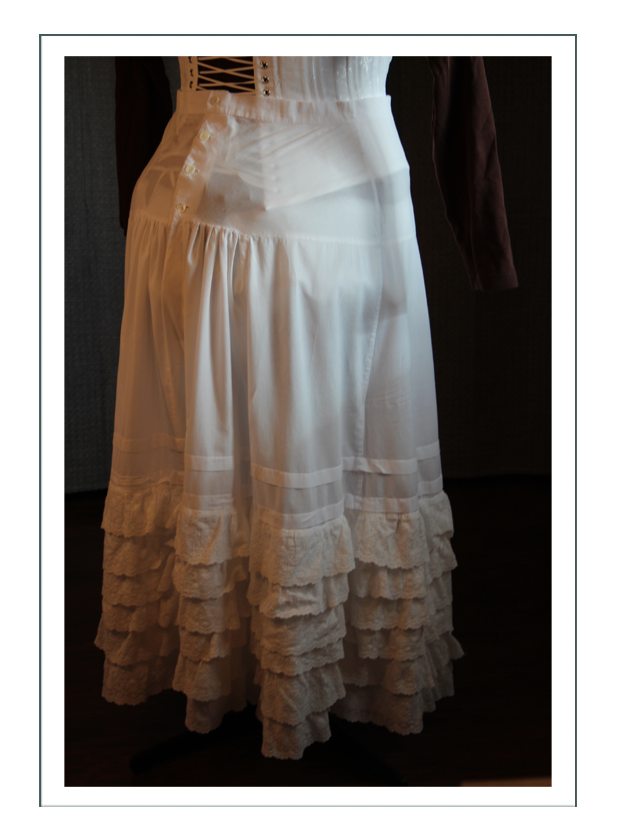
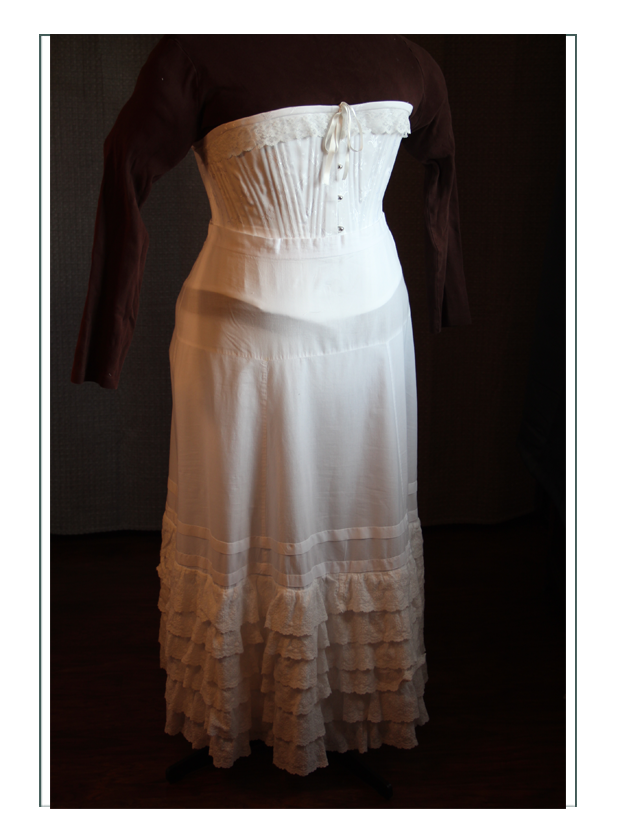
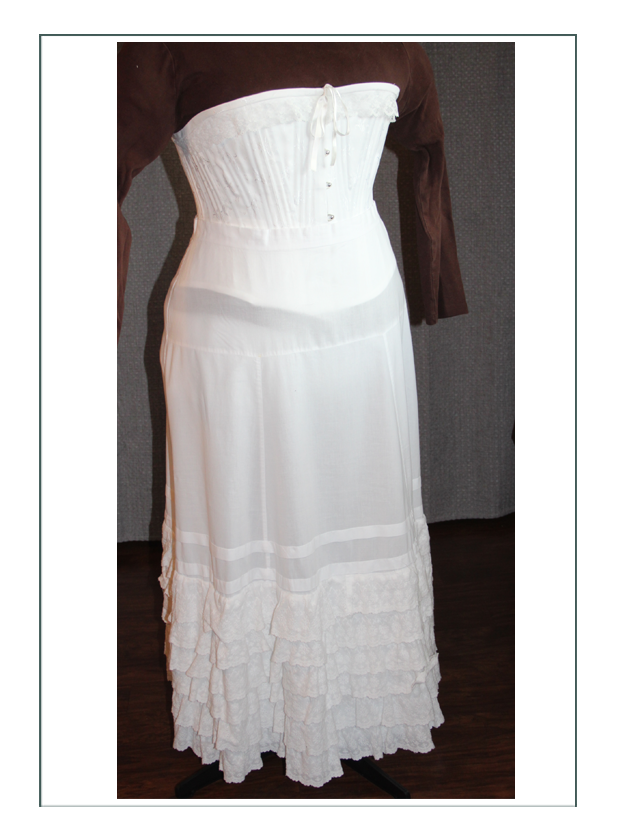
Corset Cover
This is the layer that will need washing most often, as it keeps the body temperature regulated and absorbs sweat. The smooth fit at the waist and through the neckline and mid section was key to keeping the overall smooth fit of the bodice and silhouette.
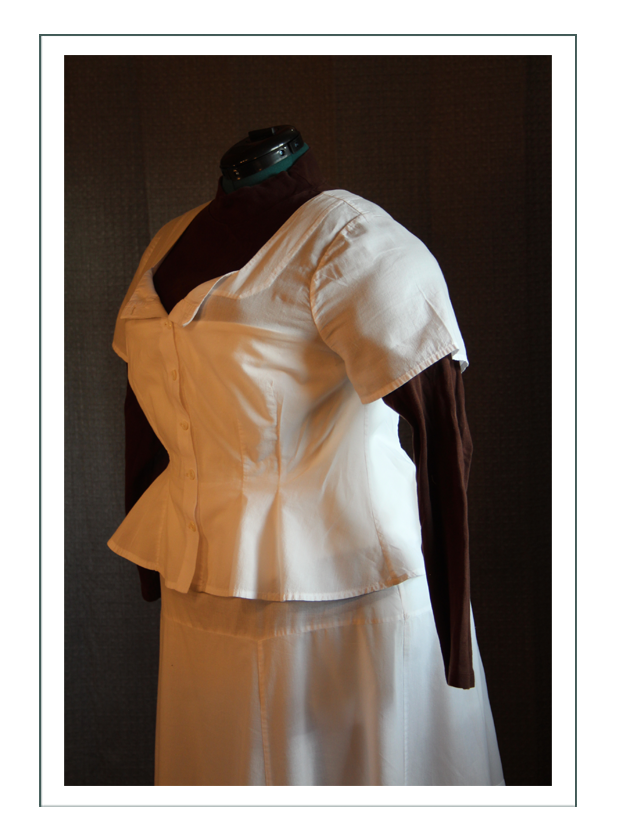
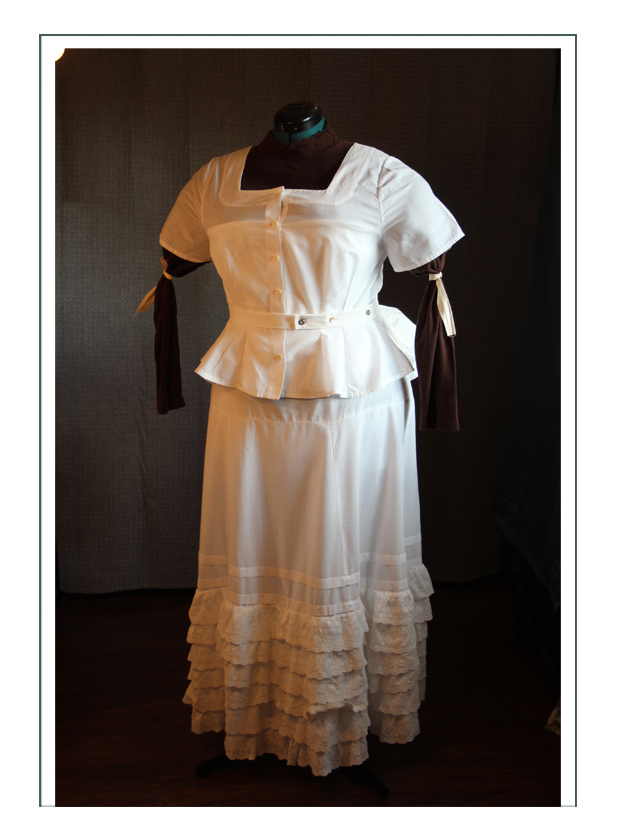
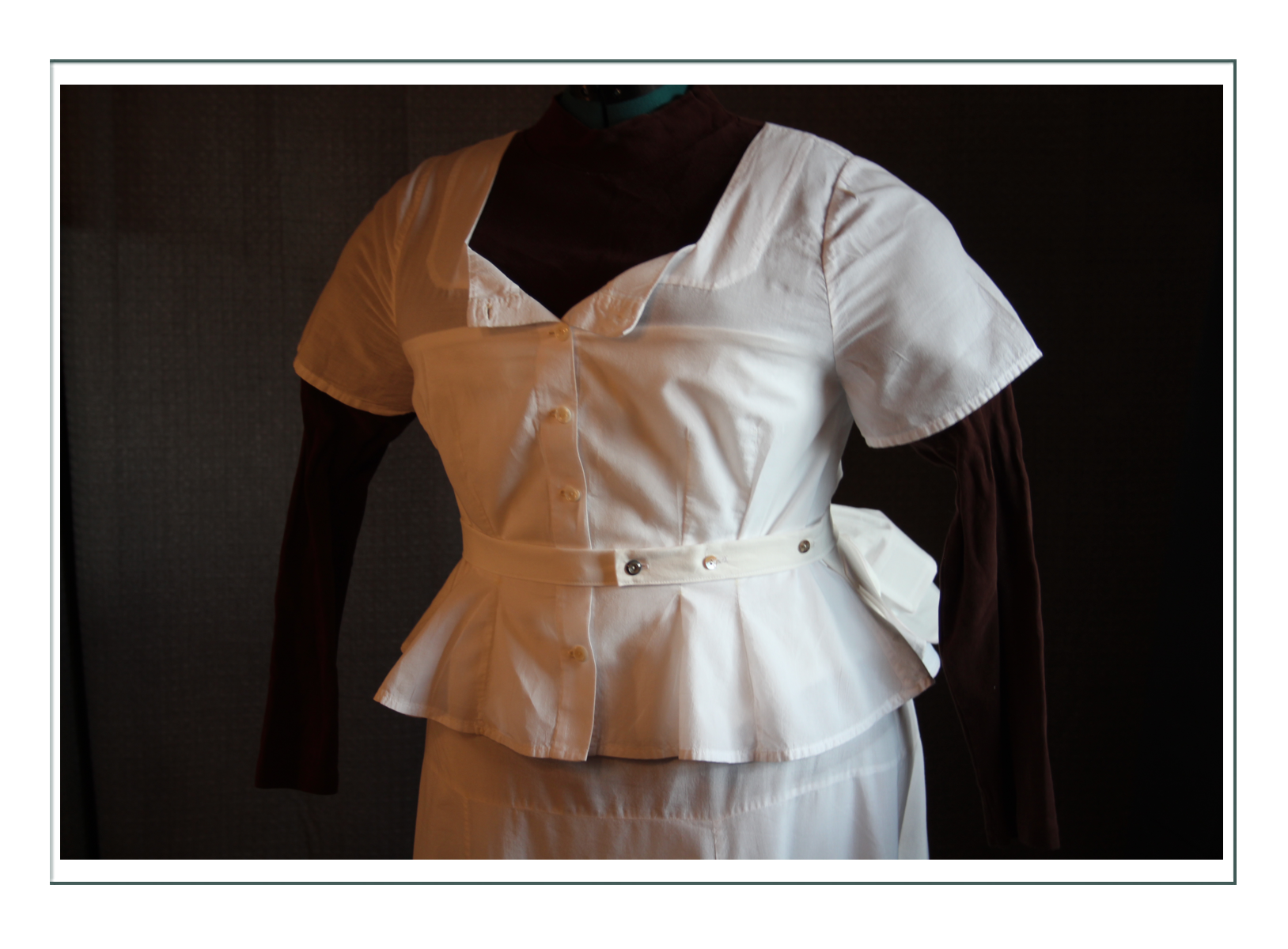
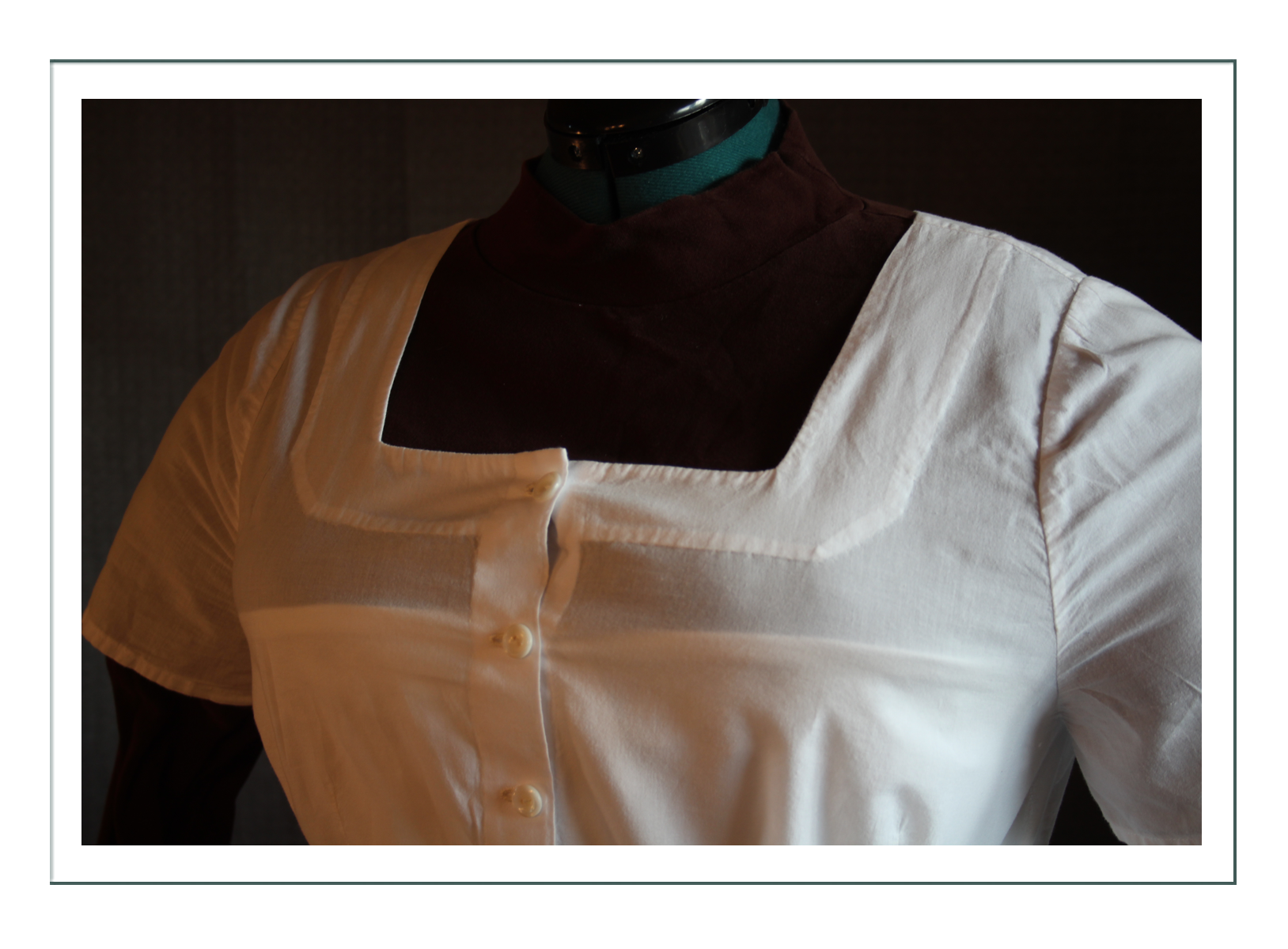
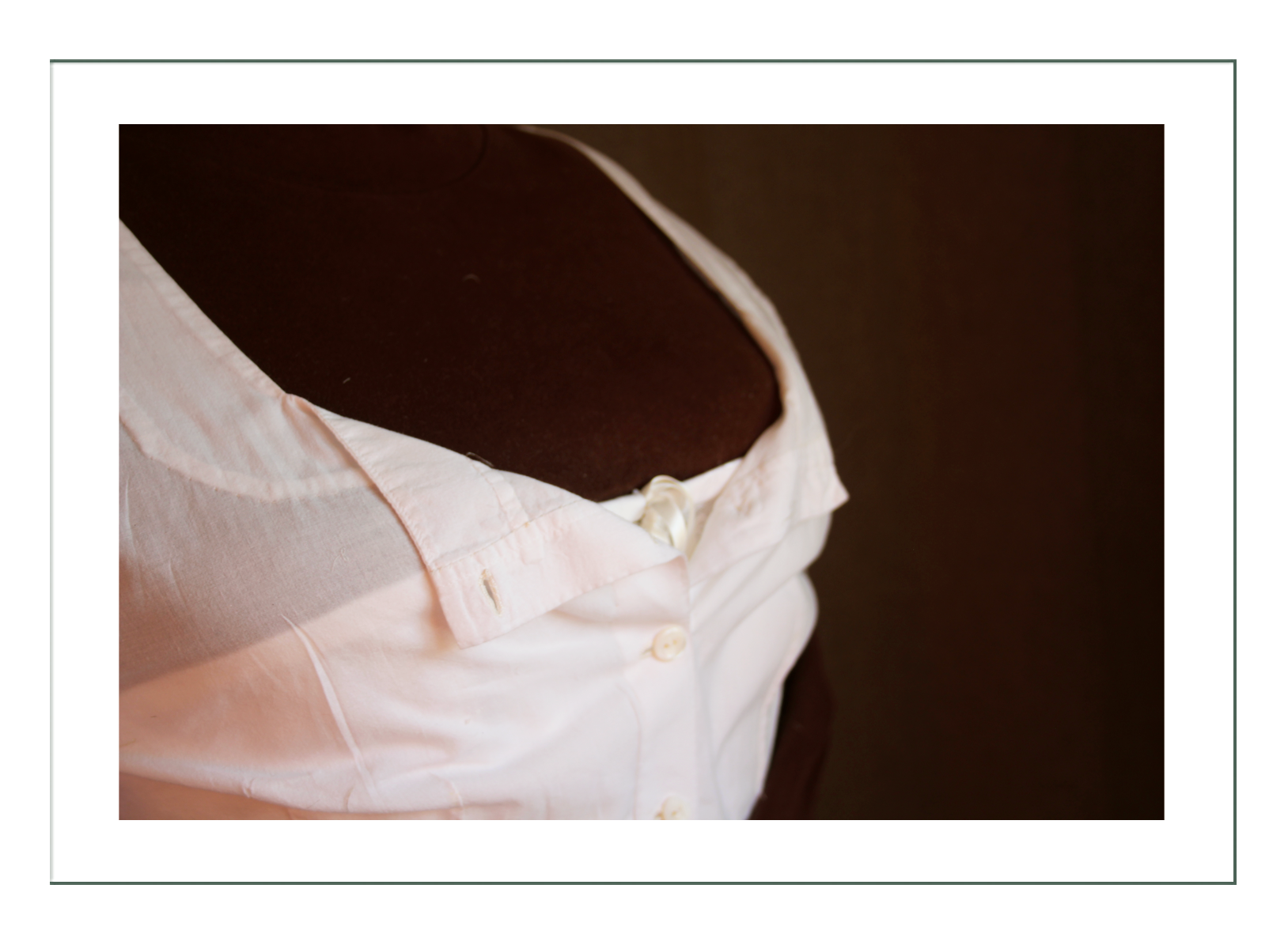
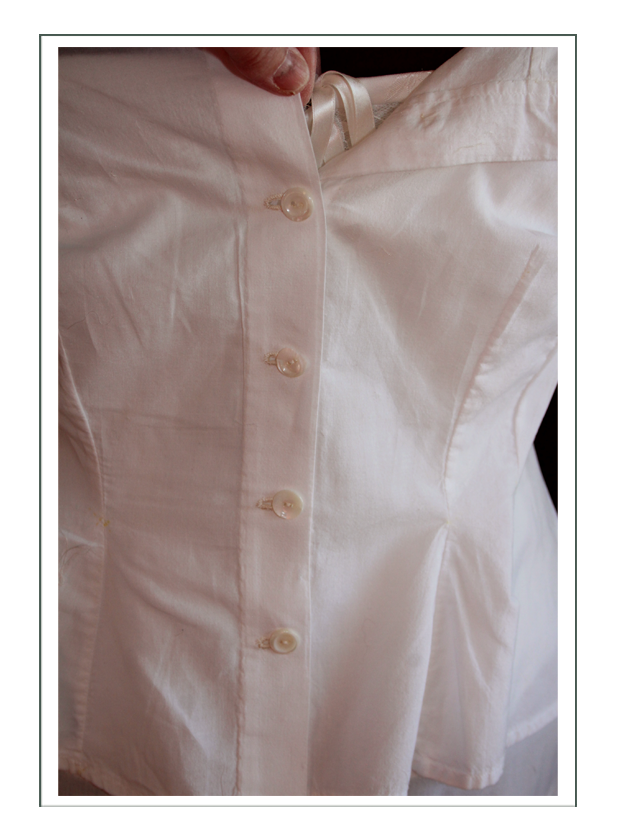
Tournure
This type of light “turning bustle” was made of horsehair in the 1880’s (plastic and cotton today). It was used when the drapes did the work of fullness, to give a little lift away from the legs for ease in walking and to assist in not having to have so much fabric. This would become a metal and larger carpentered structure as the decade advanced.
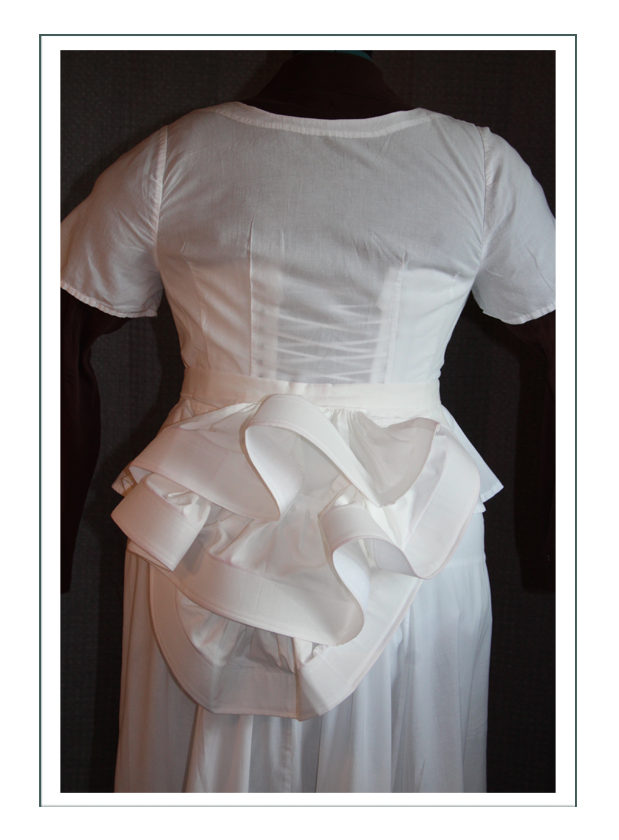
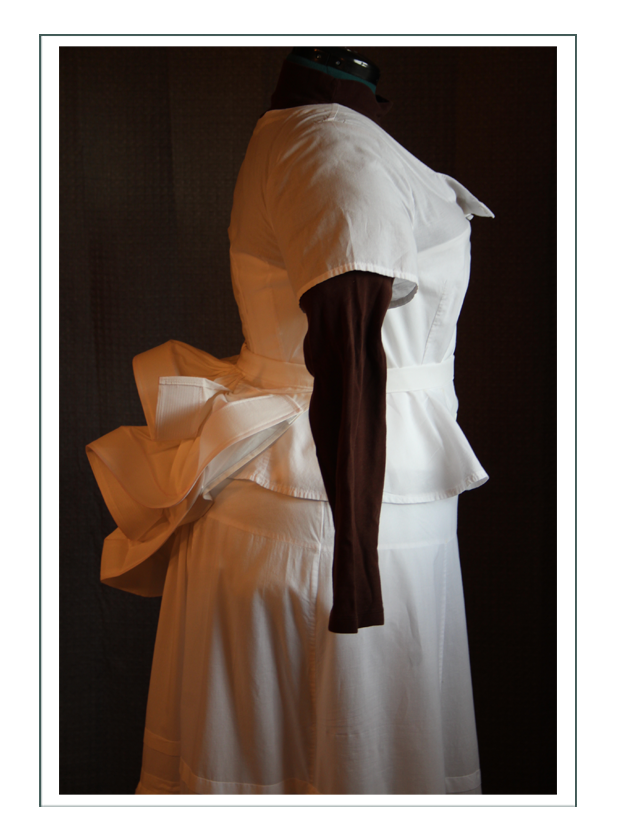
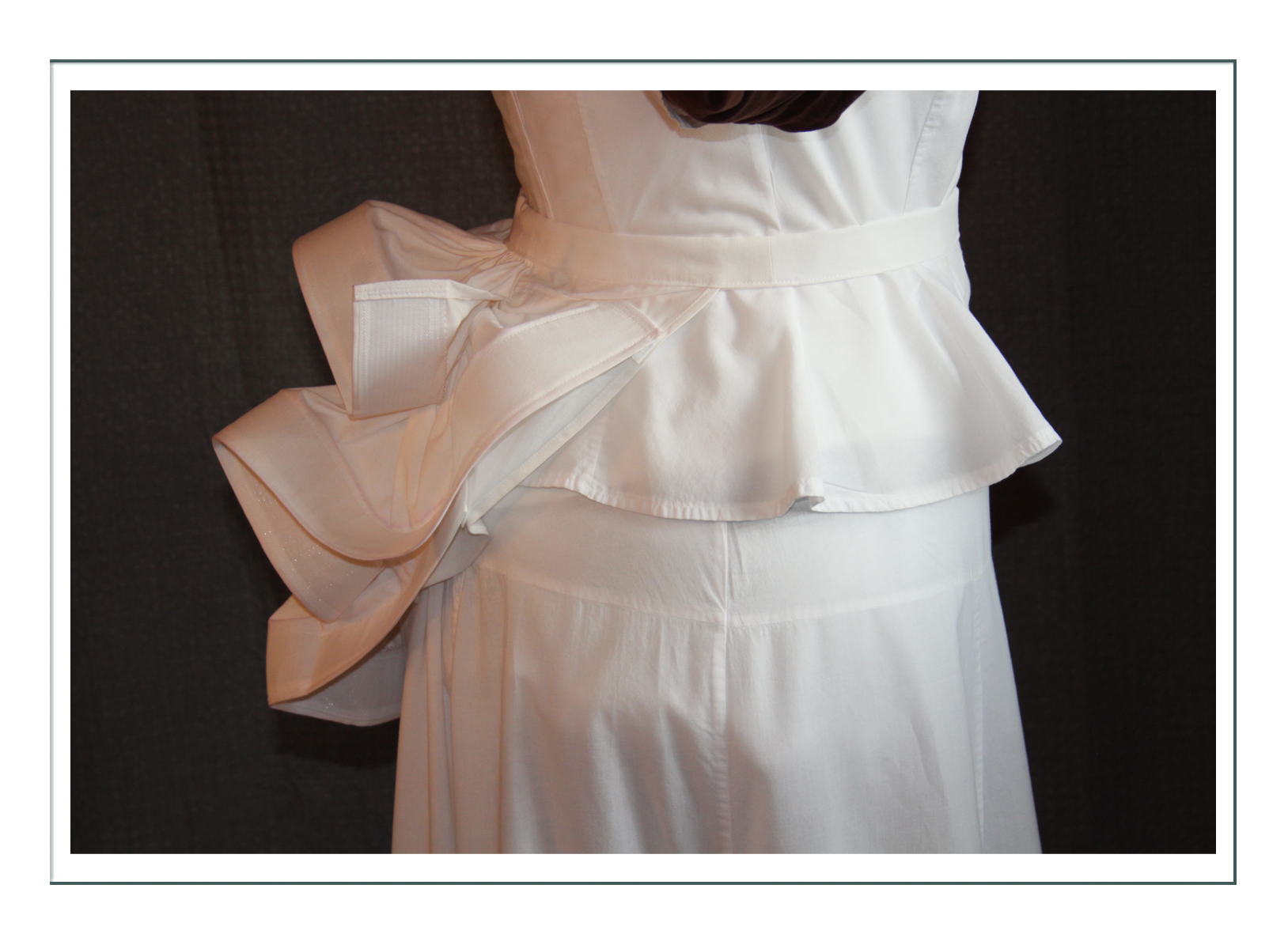
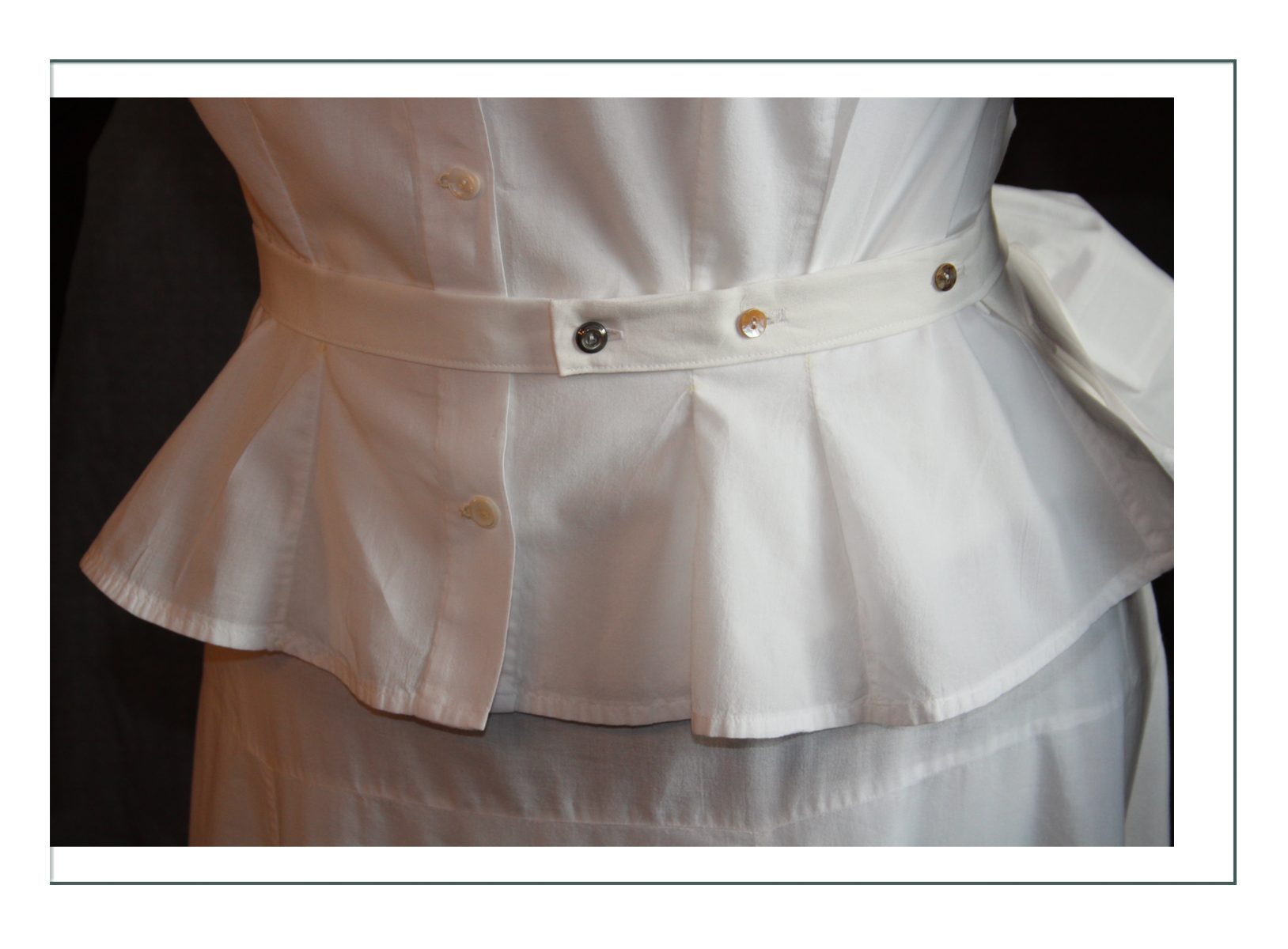

All Together

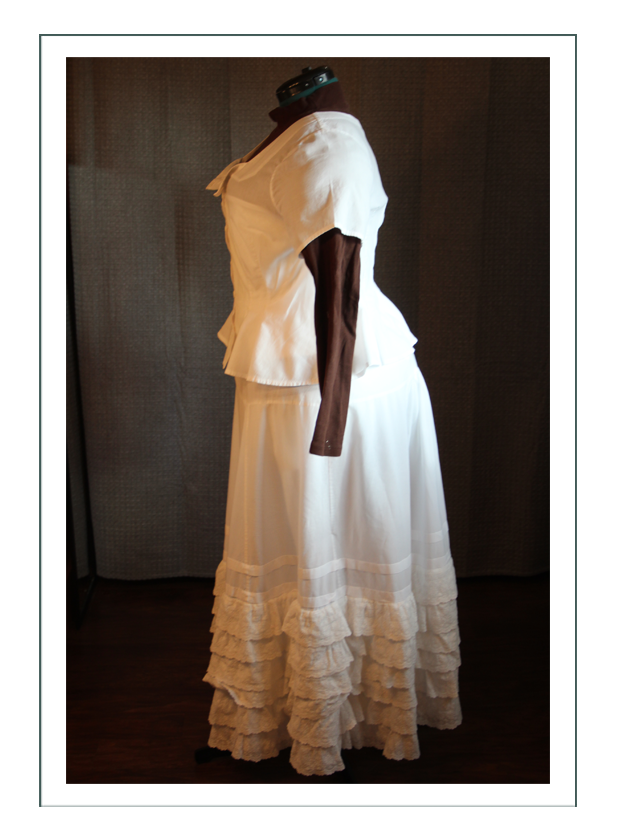
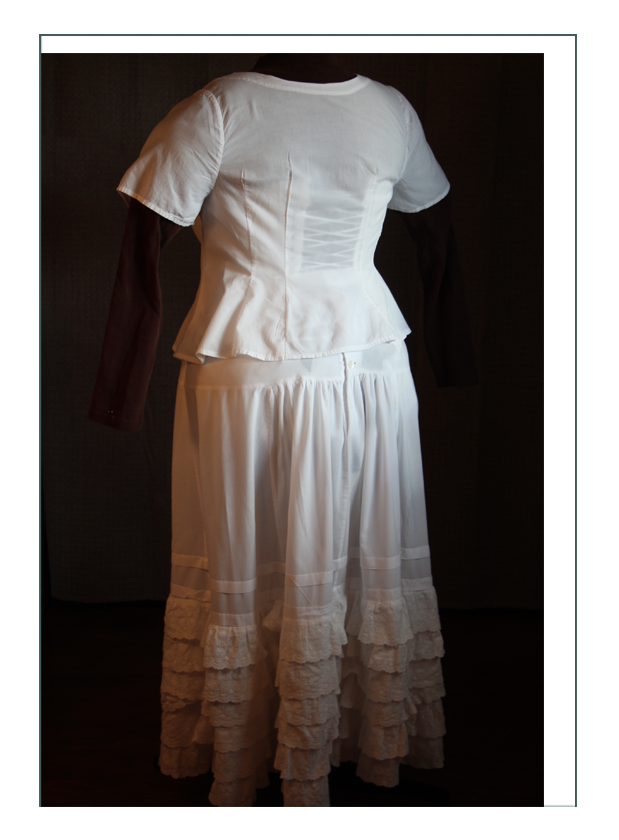

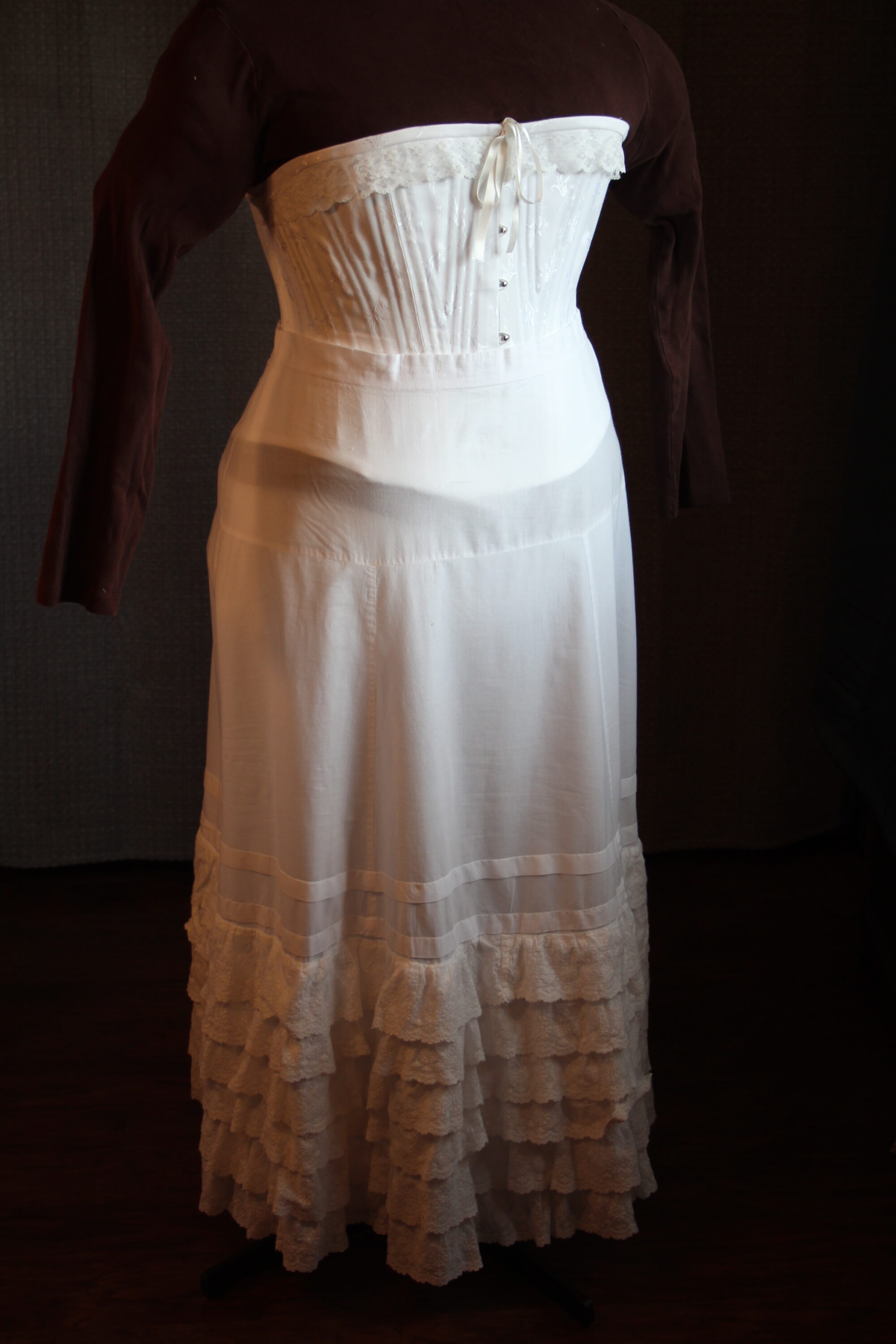
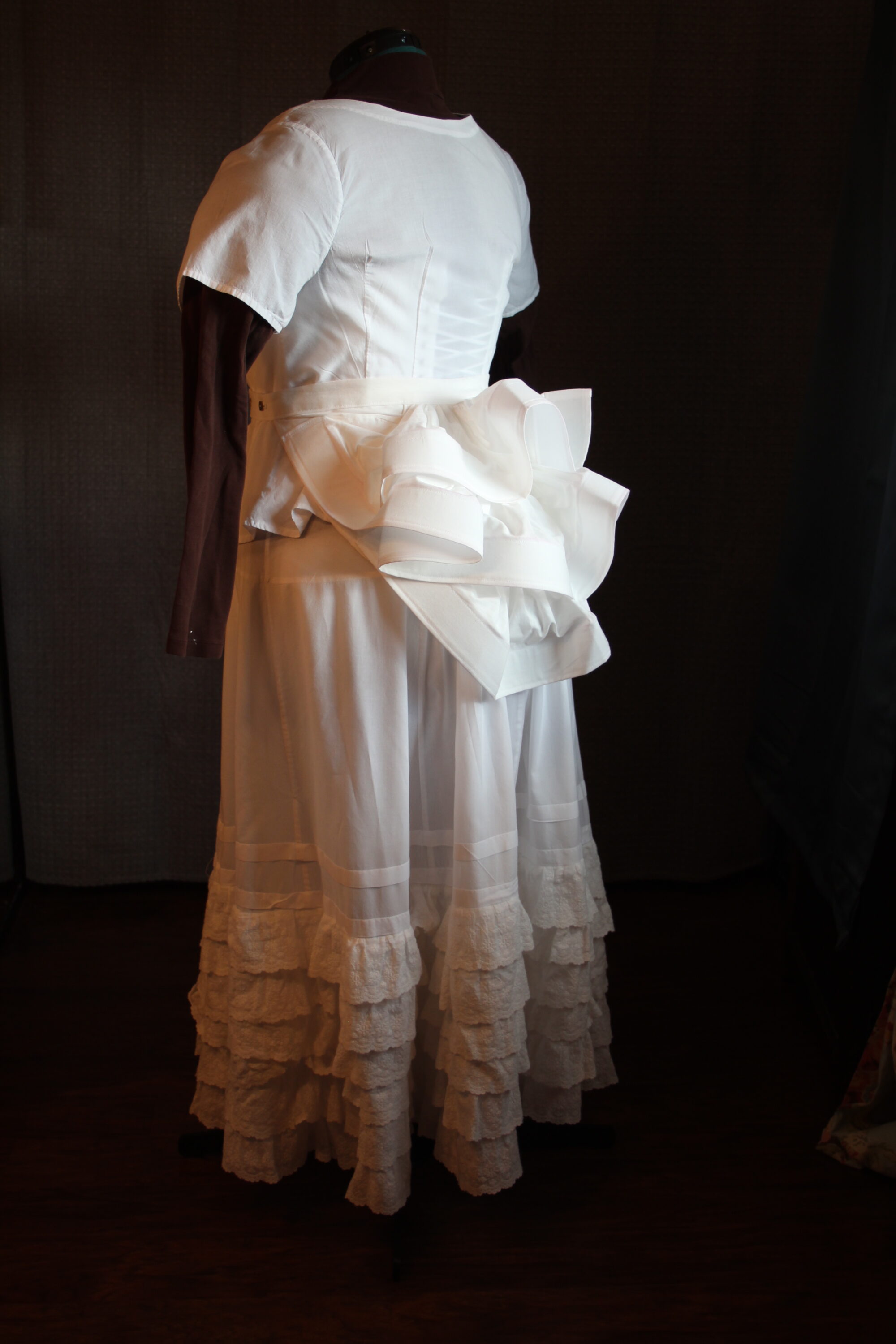

Skirt
It was a tough decision whether to integrate a train or not, and whether to make this the 5 gored skirt of the mid to late 1870’s, or the straight version of the early 1880’s. Because this was a wedding dress, and because Rebecca didn’t mind a bit of a mix of eras, we chose the longer, fuller version because of its drama. We added deep pleats which allowed easy walking, and there is a drapery cord inside to hold the fabric back behind the legs for easy walking, and to give the straight vertical appearance in front.
They did not use buttons at that time which allowed for more adjustability as they used skirts a lot for different undergarments and then just switched out bodices (you might wear this skirt for your wedding and a church social, but the bodice would be different). We have included a lovely Victorian reproduction pin similar to what they would have used, which is basically a safety pin. They actually used safety pins that were similar to today’s for this.
The petticoat and drapes would have been pinned too, but we put buttons on those. The most interesting thing about both this and the bodice is how similar in design and construction they are to 18th century, specifically 1770’s garments. Parisian high fashion designer Charles Worth of the House of Worth at the time had told his patron Eugenie of France that this design was uniquely his and new in the world. yet this and his other concepts look exactly like Georgian fashion.
Even down to the boning which is in the seams to keep the bodice from flopping, folding, or falling down, it’s the same as the 18th century. The only difference is 1880’s used waistbands and pins vs. waist tapes and ties. End result is the same: very adjustable and flexible garment for repeated use.
The skirt also has a tie on the train to lift it on the wrist or loop it on the button for wedding dancing. It has a silk facing so it’s easy to clean the hem.
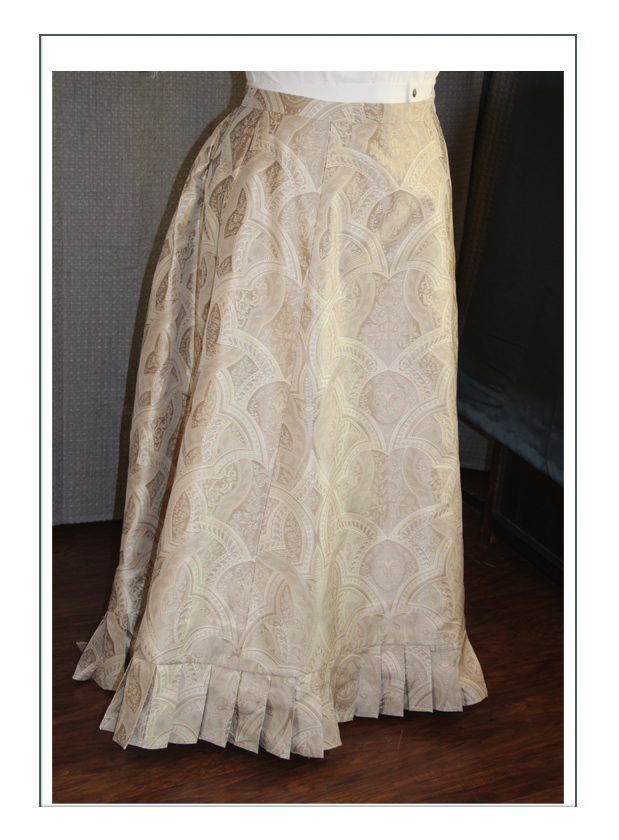
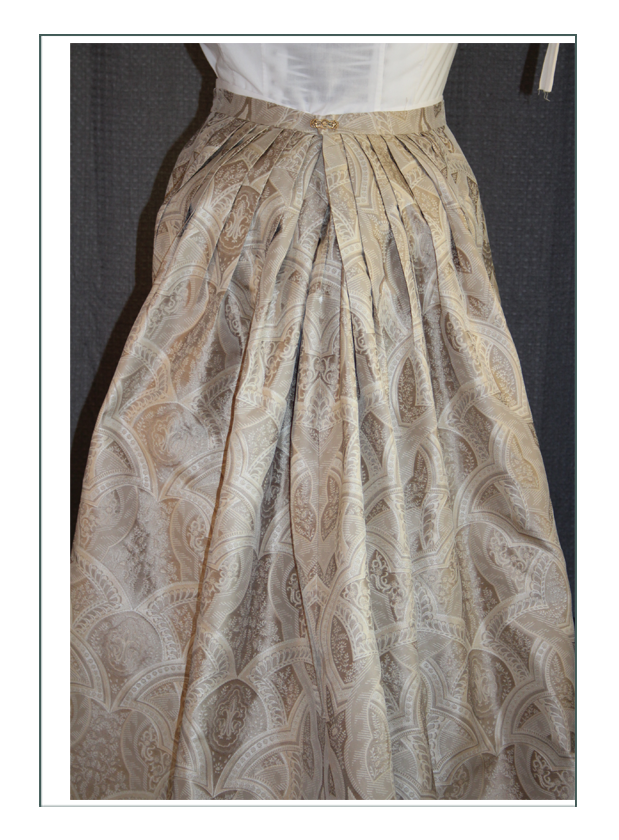
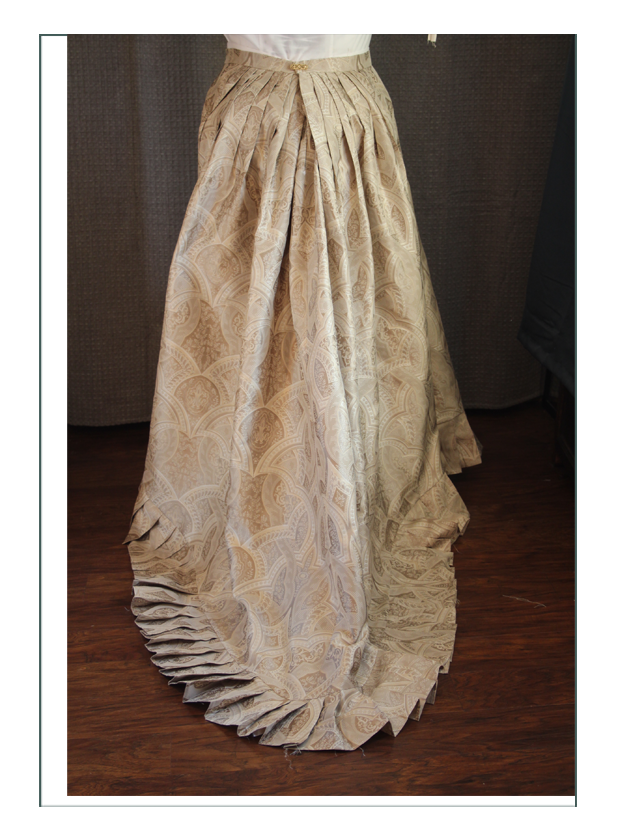
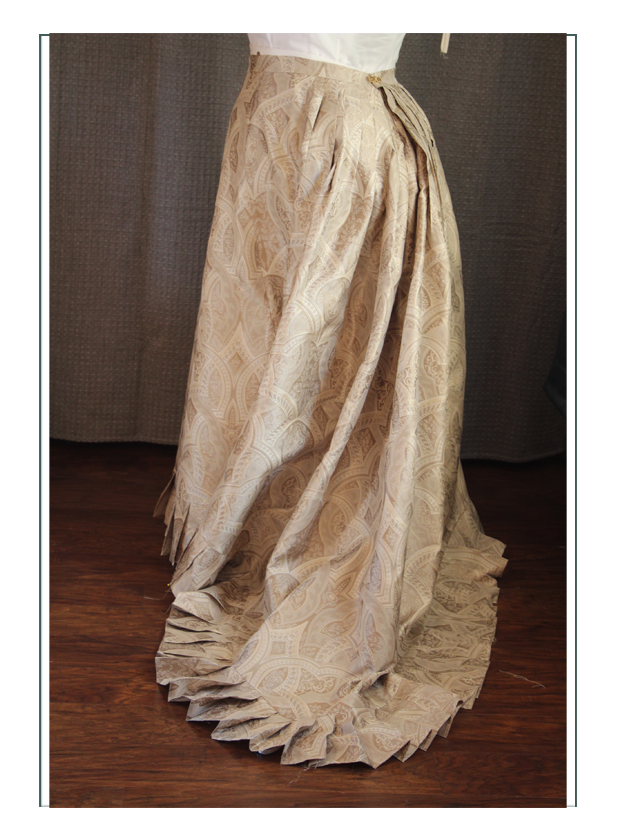
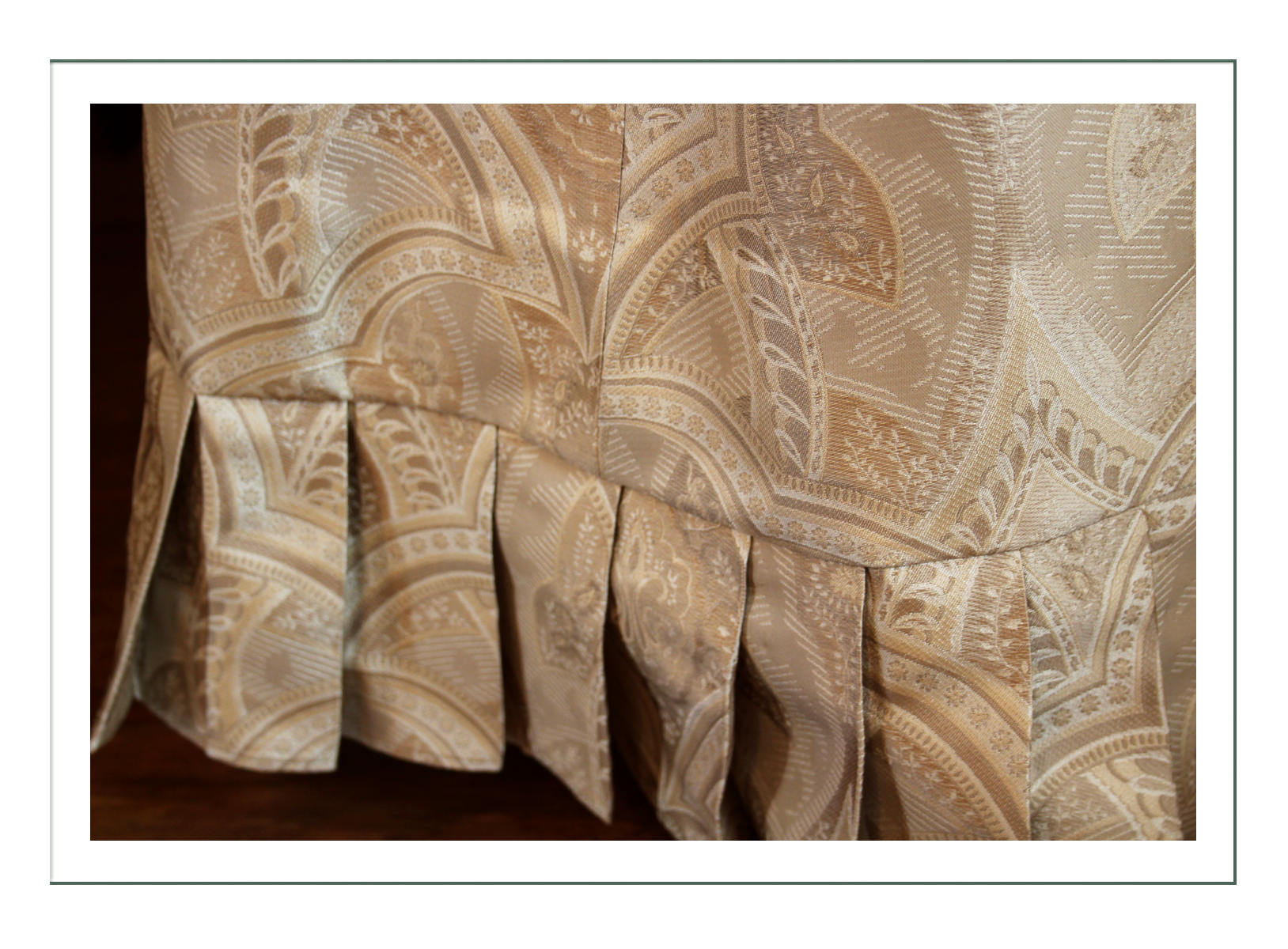
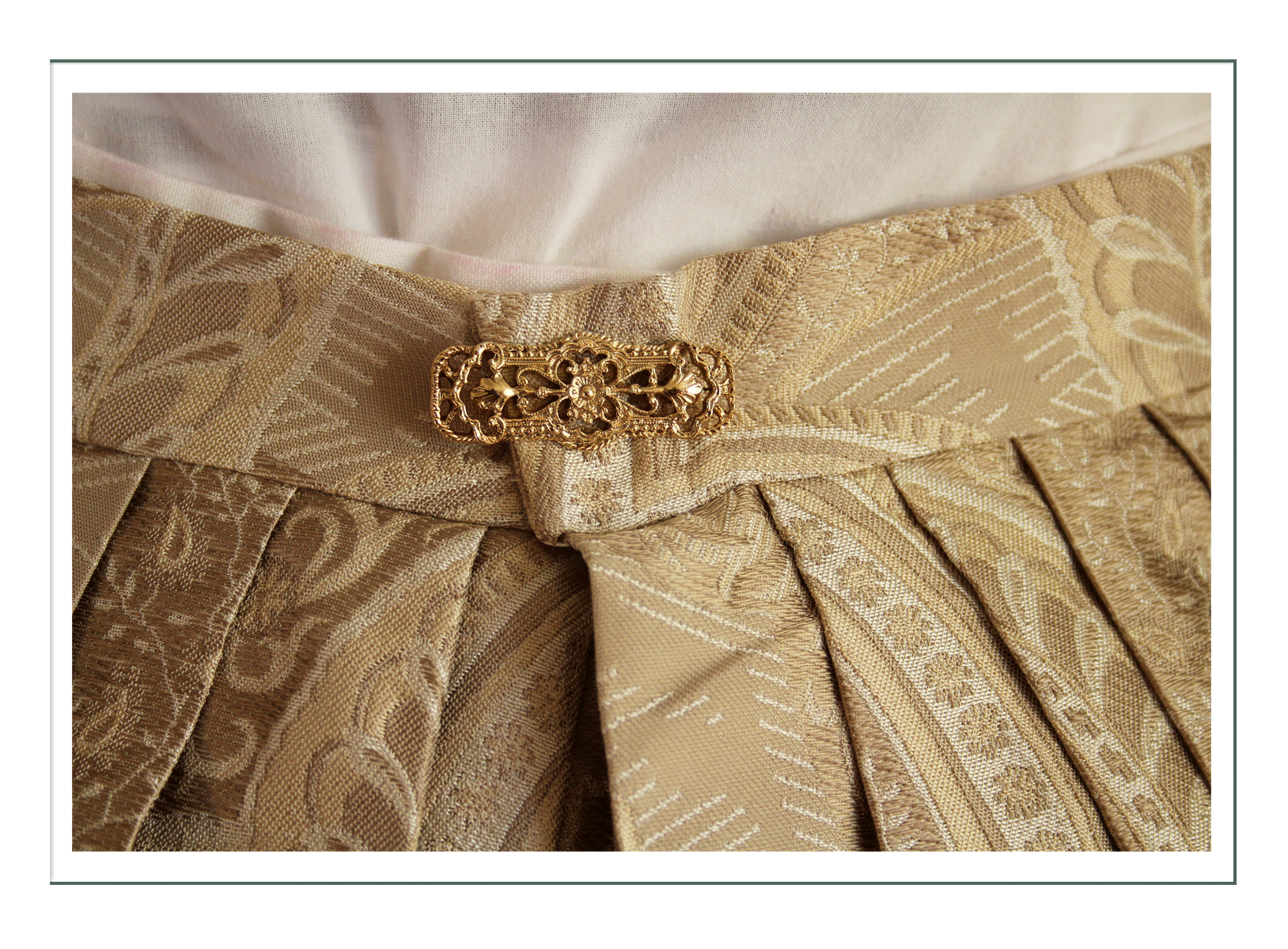
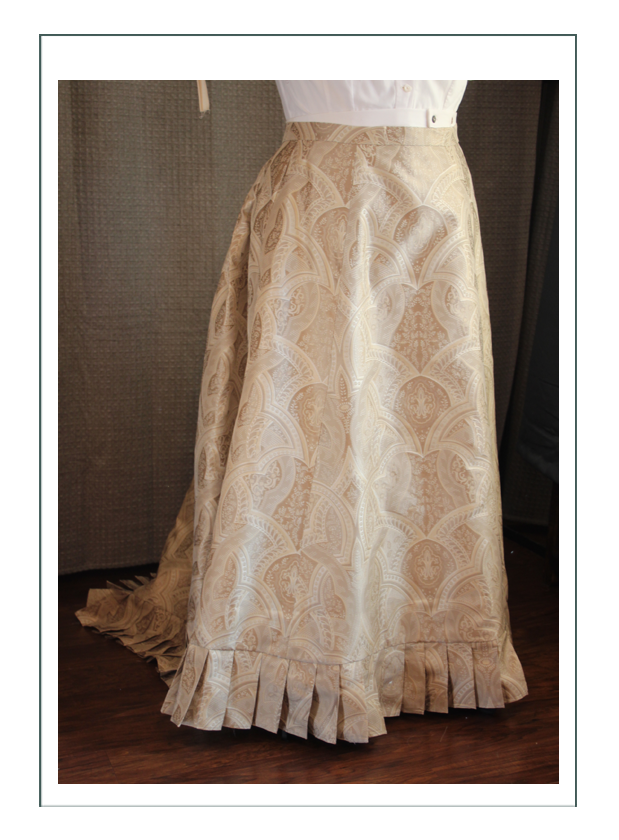
Bodice
The goal of the bodice is to be tightly fitted, including the sleeves. Typically except for formalwear, the neck was covered up entirely by a lace insert. Remember, they did not have “blouses” yet, and most inserts were “revers”, or a piece of fabric sewn in, and not a full garment. We provide the lovely lace detail of the era instead of the revers or chemisette.
Those are actual turned cuffs using the contrasting silk taffeta, and a uniquely designed collar based on a garment at the time that was worn by the Empress Maria of Russia.
The bodice is fully lined in silk, and has authentic mother of pearl domed shank buttons from the era. We designed the bodice to be a bit shorter than fashionable to trick the eye a bit into seeing Rebecca as being really tall. Adding 2″ heels helped that.
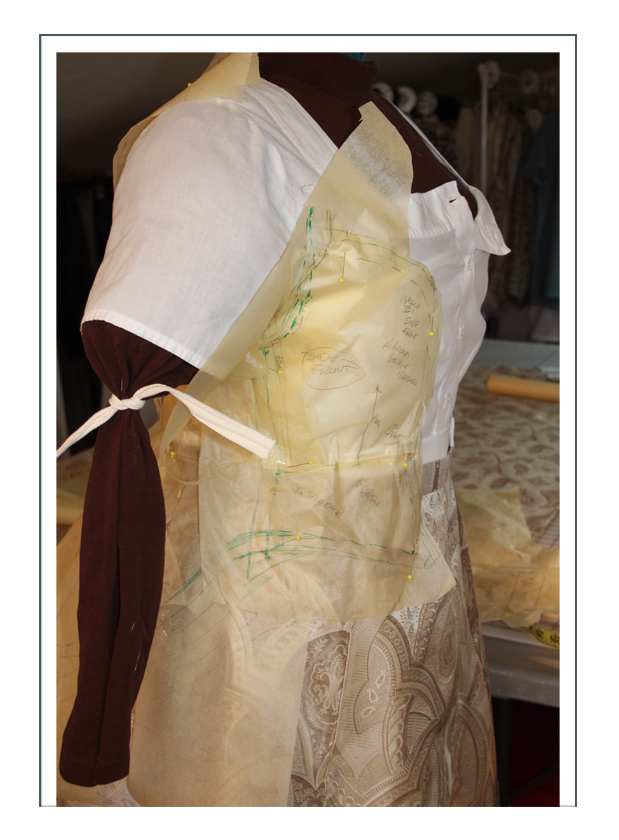
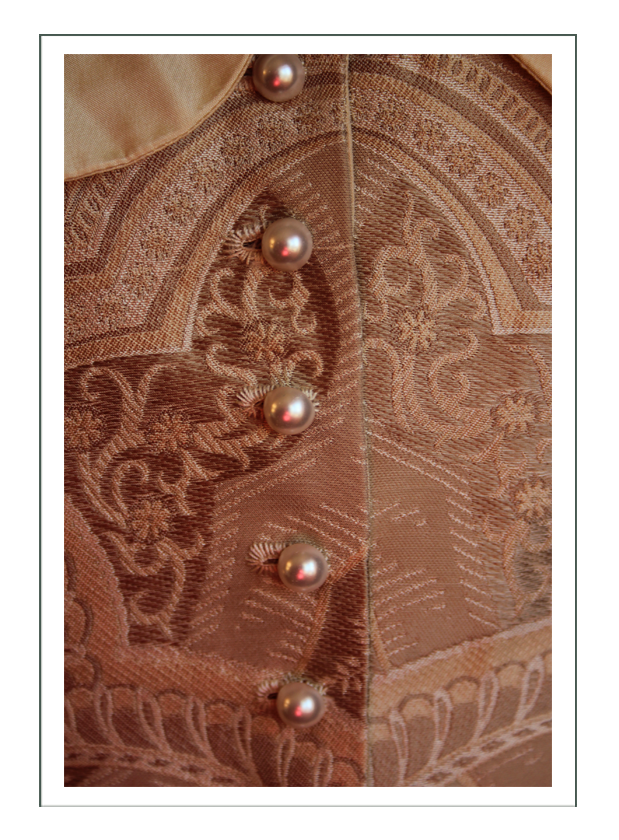
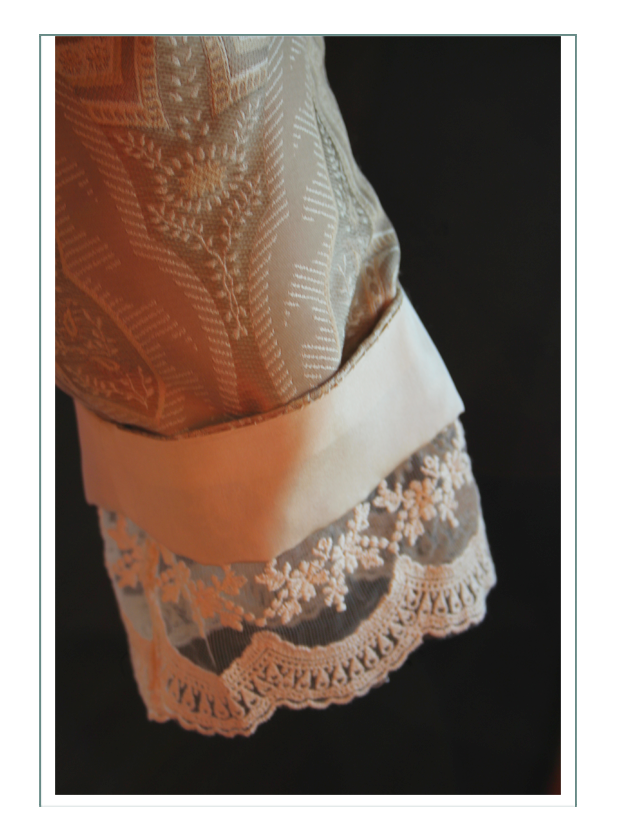
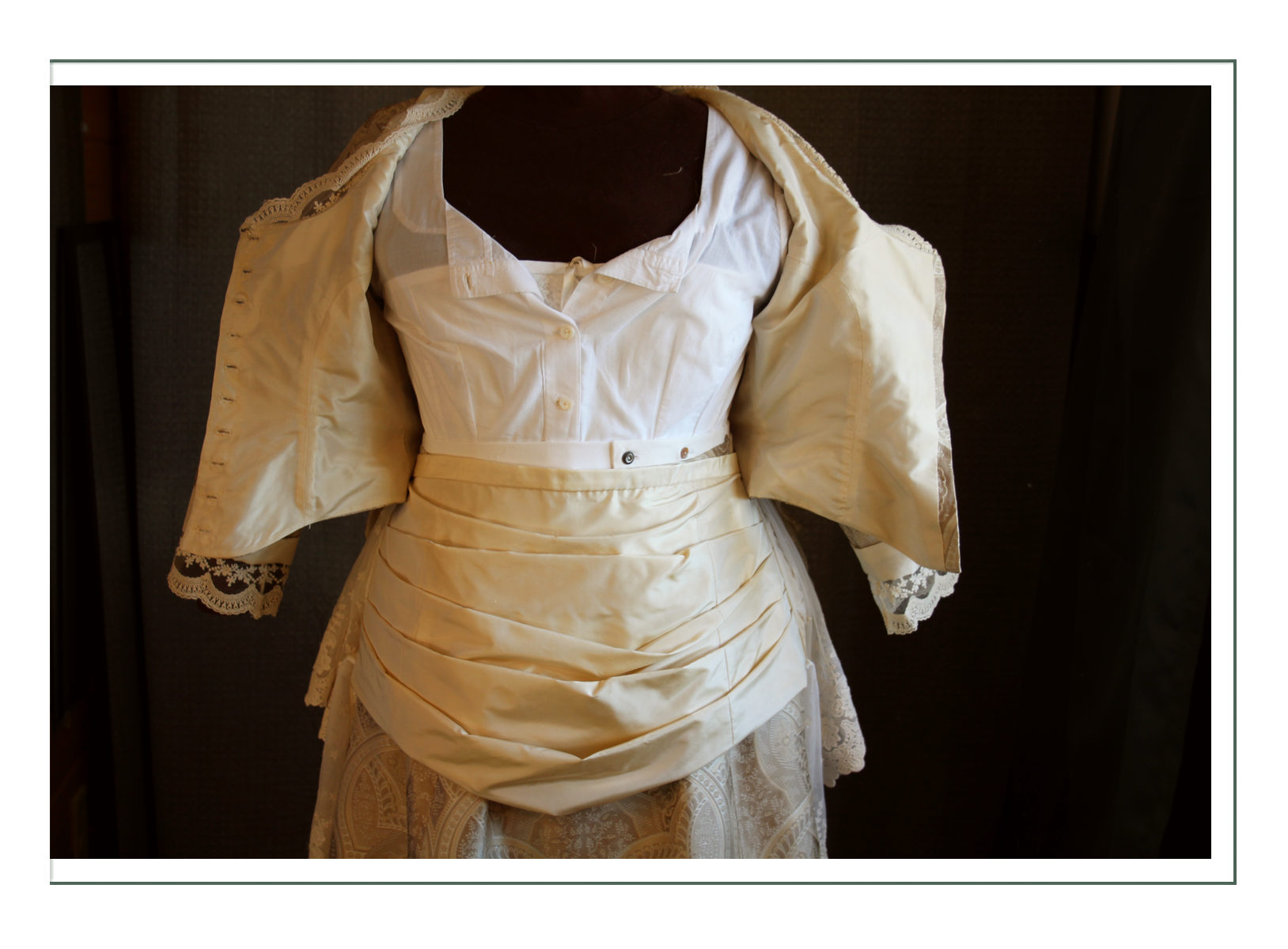
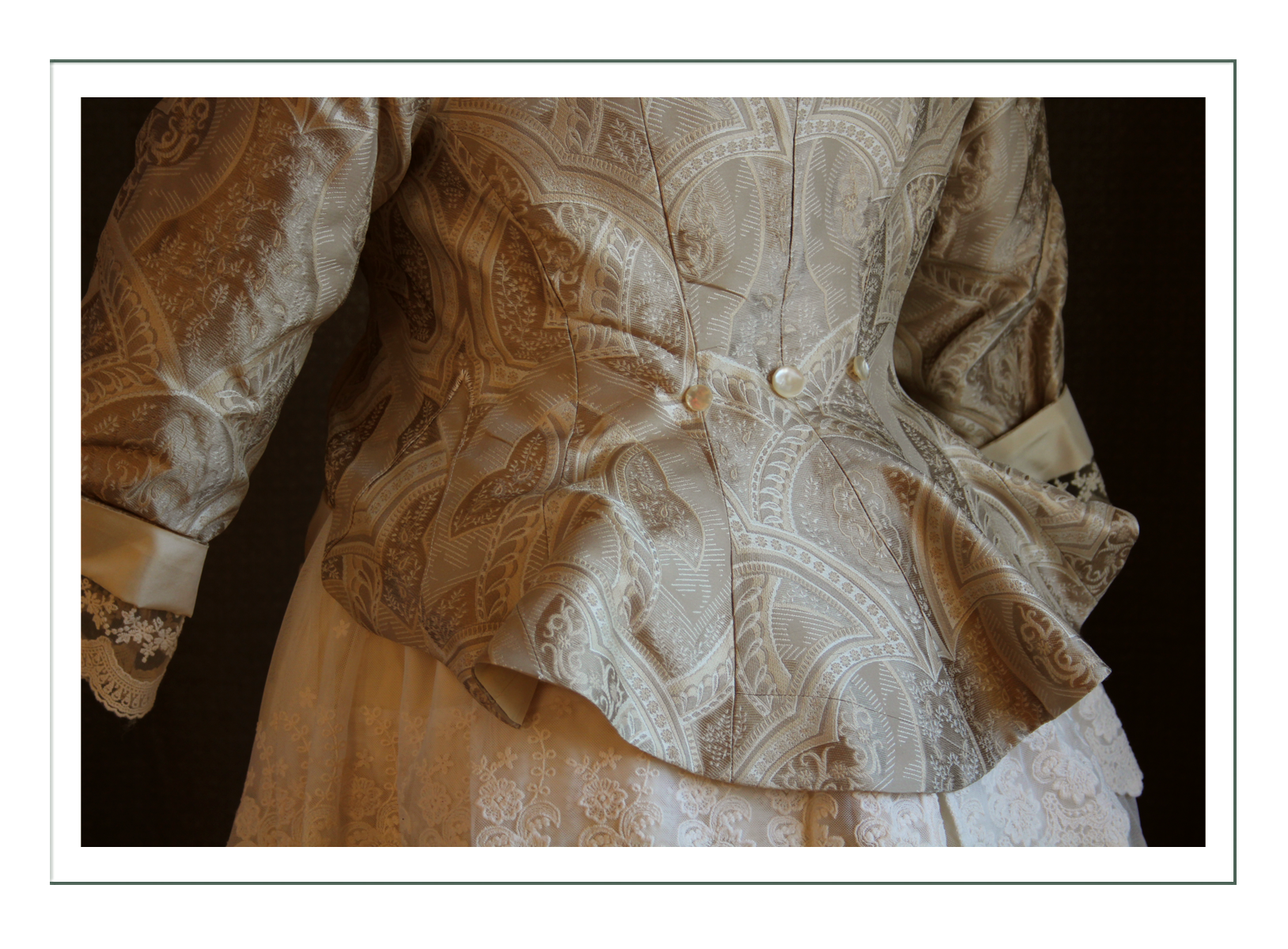
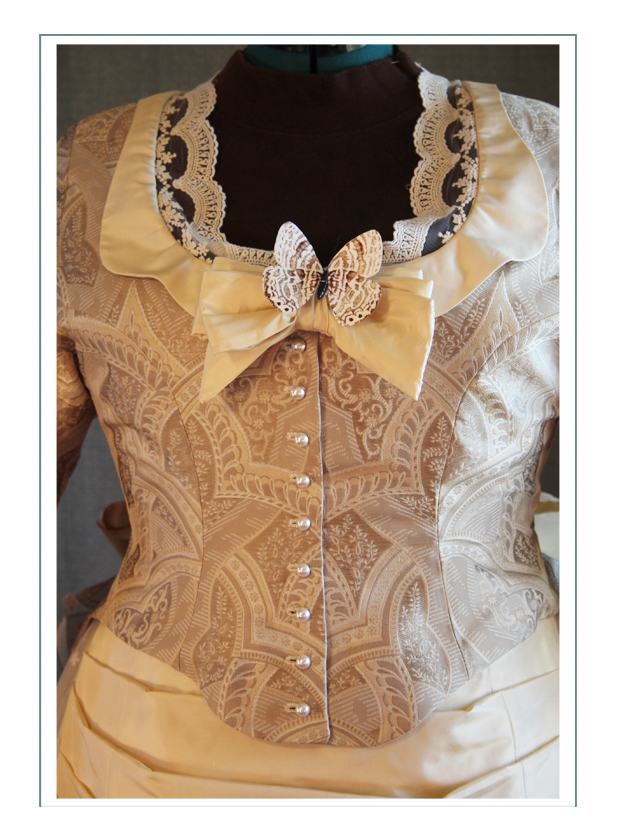
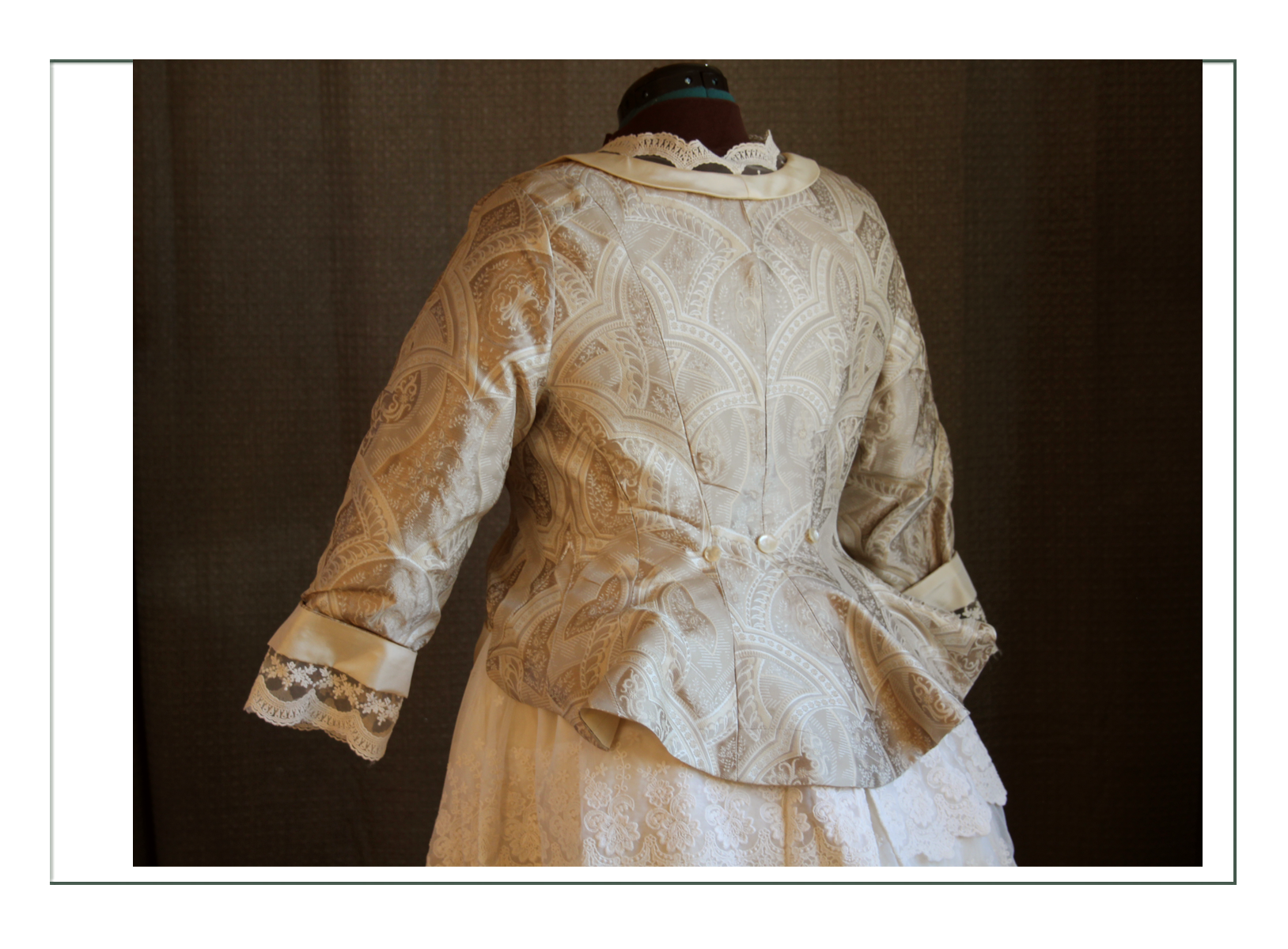
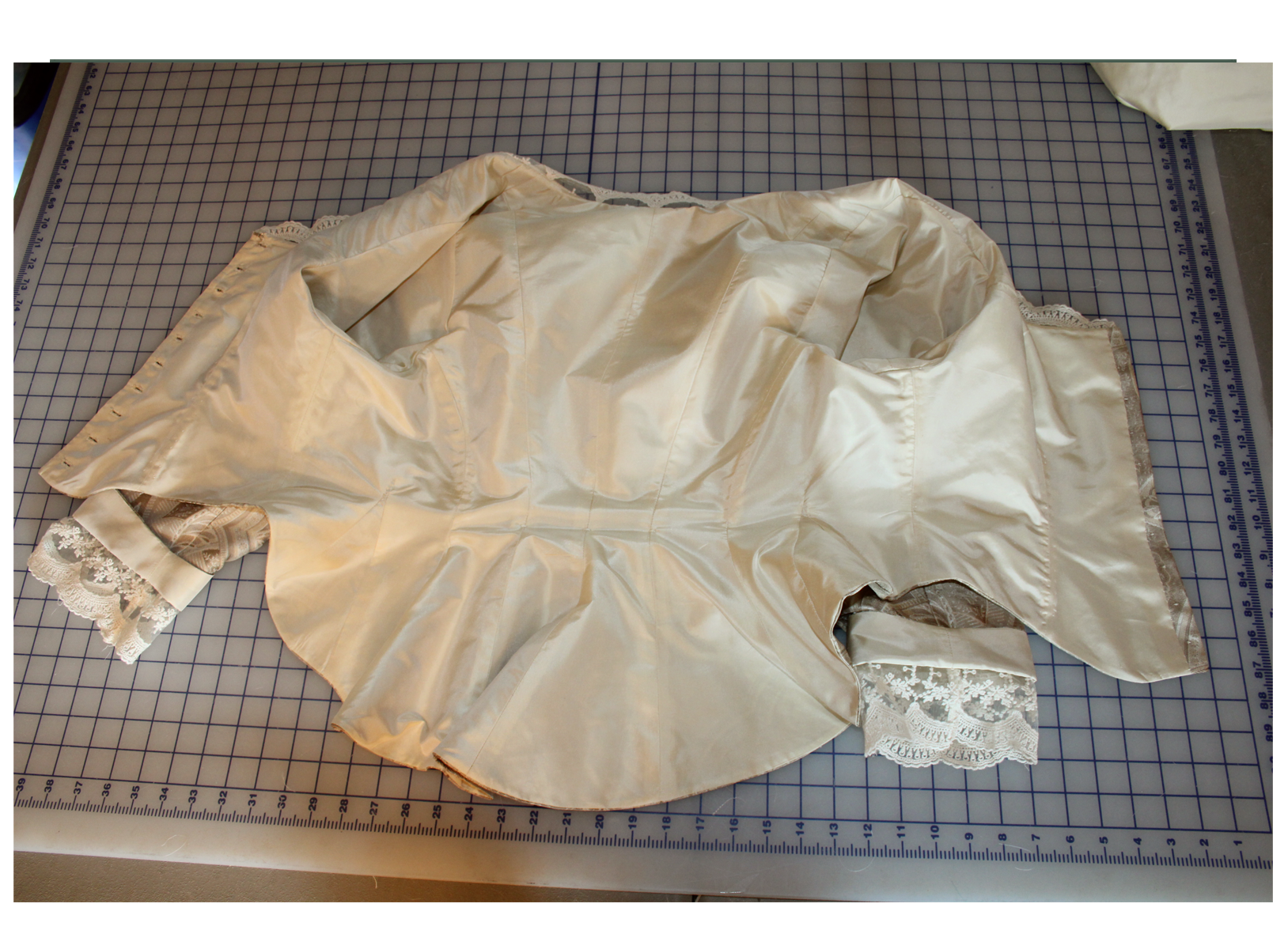
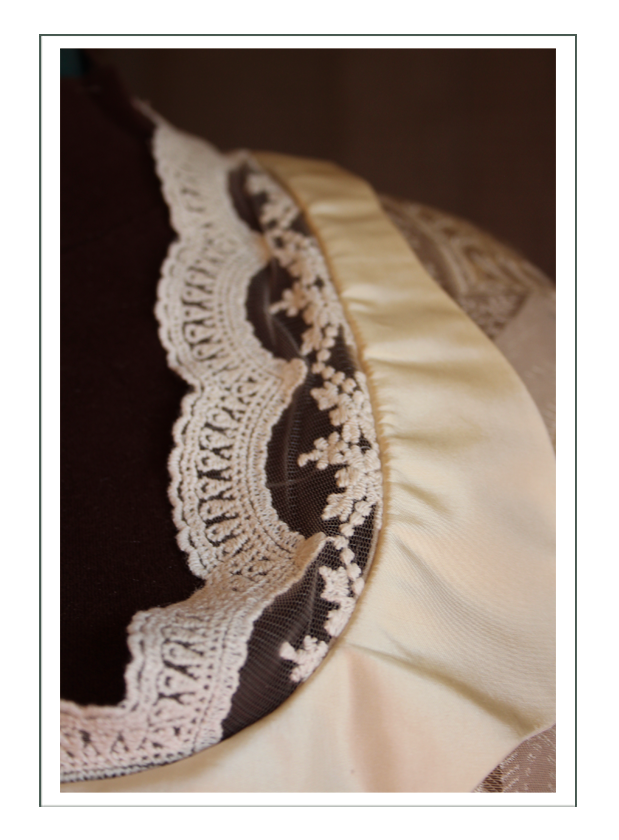
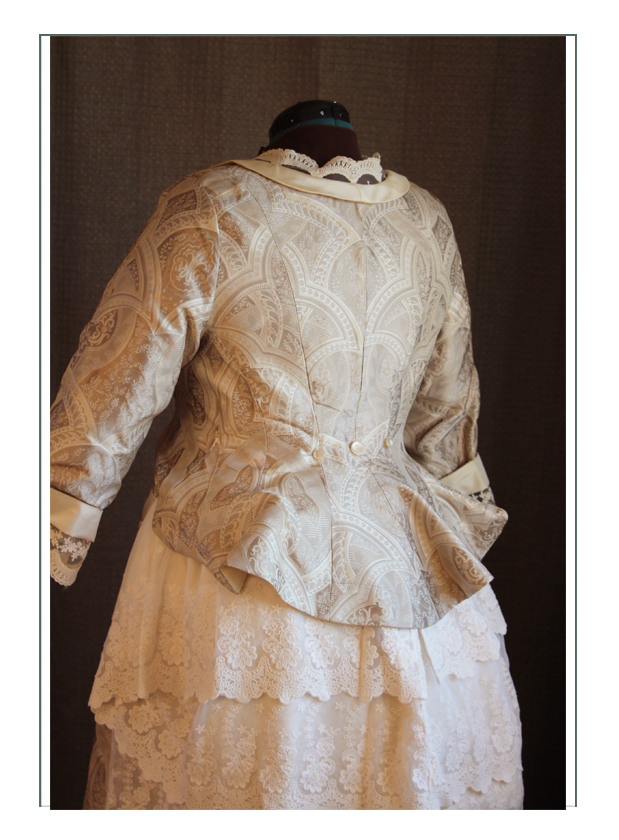
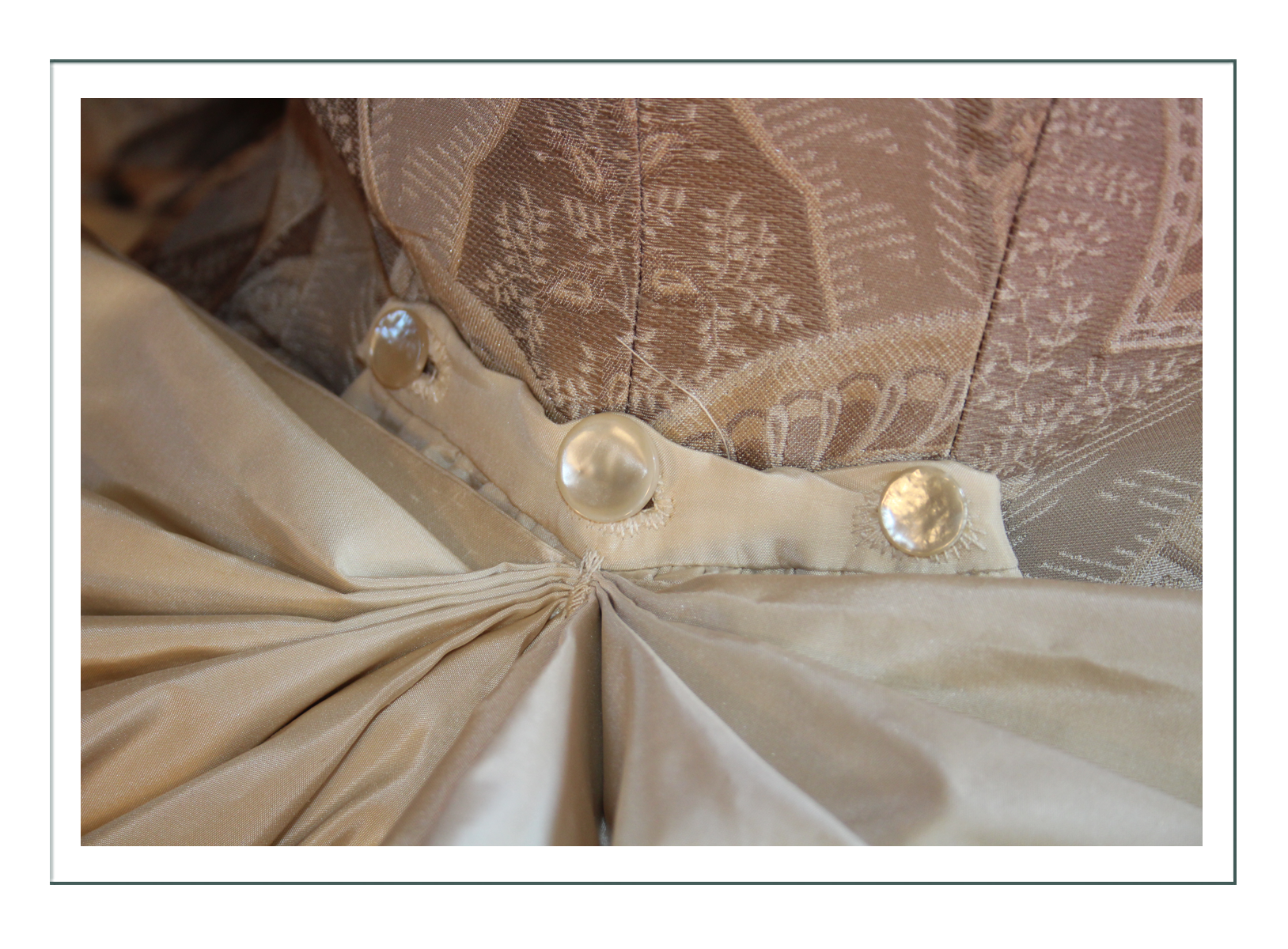
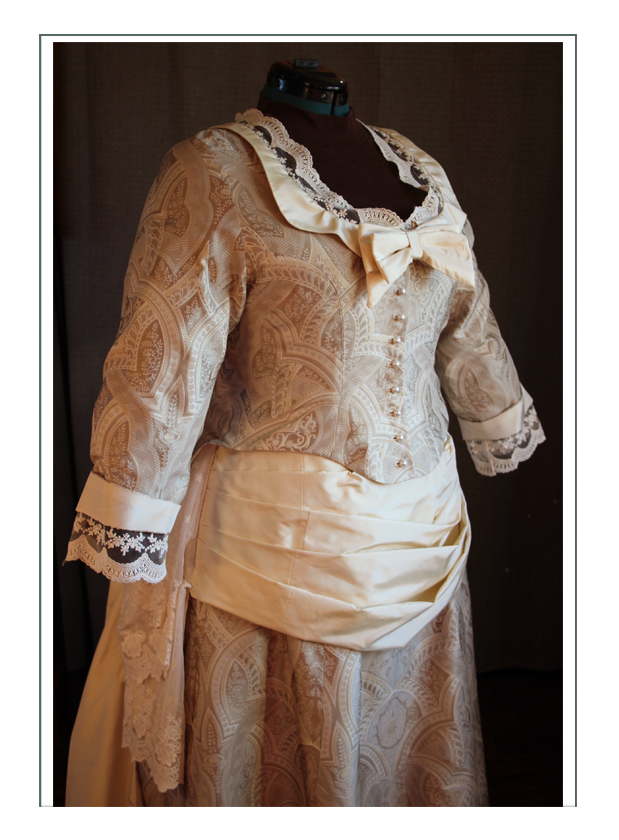
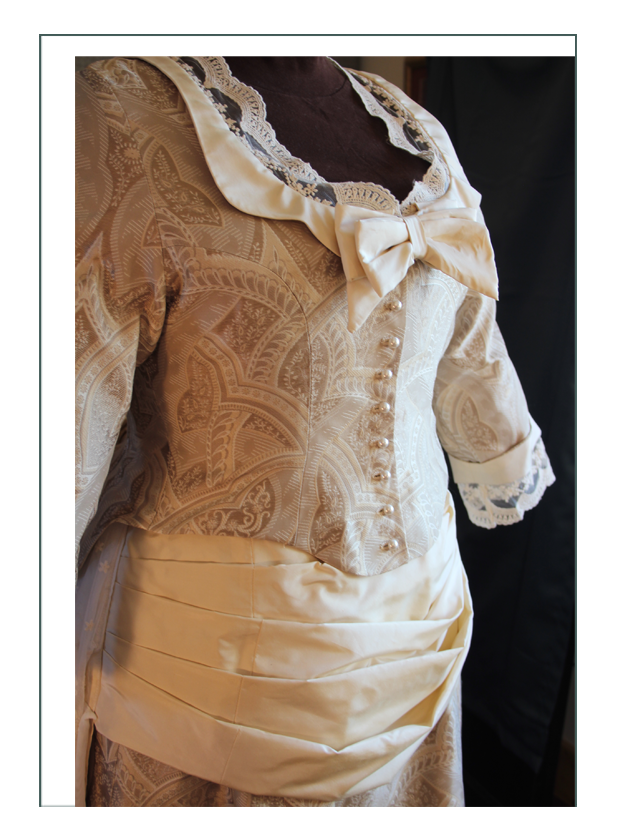
Apron Drape
Rebecca requested the shorter, flatter version of the drape. This brought the sides around towards the front more than the longer, fuller aprons in order to keep the tension horizontal. Lovely 100% cotton embroidered edging lace which matched the taffeta, covered the seams and added fullness to the hips to give an even more curvy look.
This could be worn with or without the butterfly train, and the idea was to wear this at the reception, to dance with the loop in the skirt on the wrist, and to wear it this way for future “traveling suit” depictions which gives it a much less formal look.
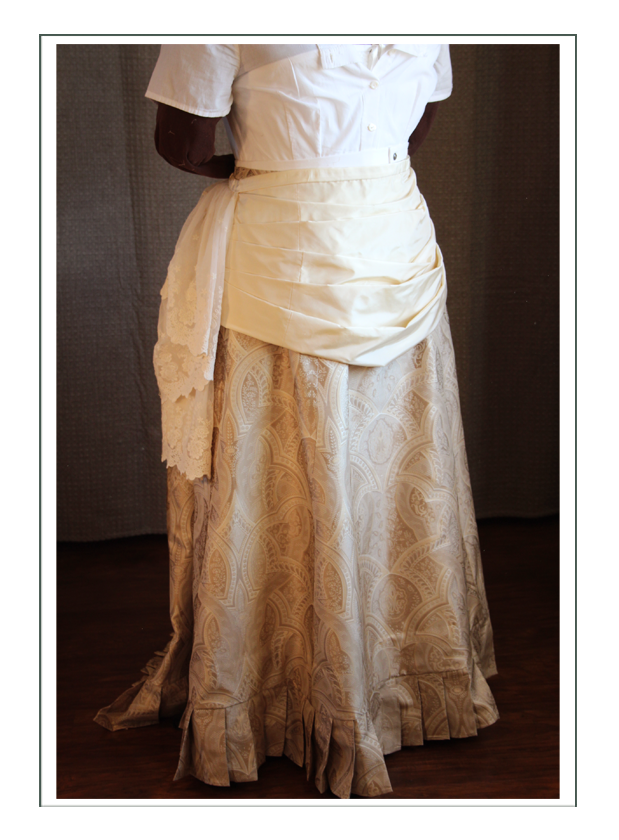
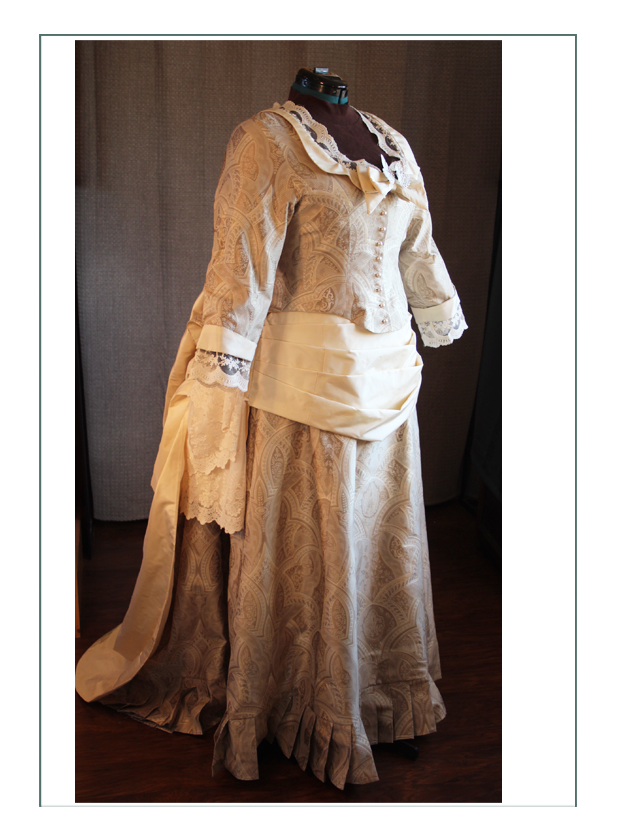
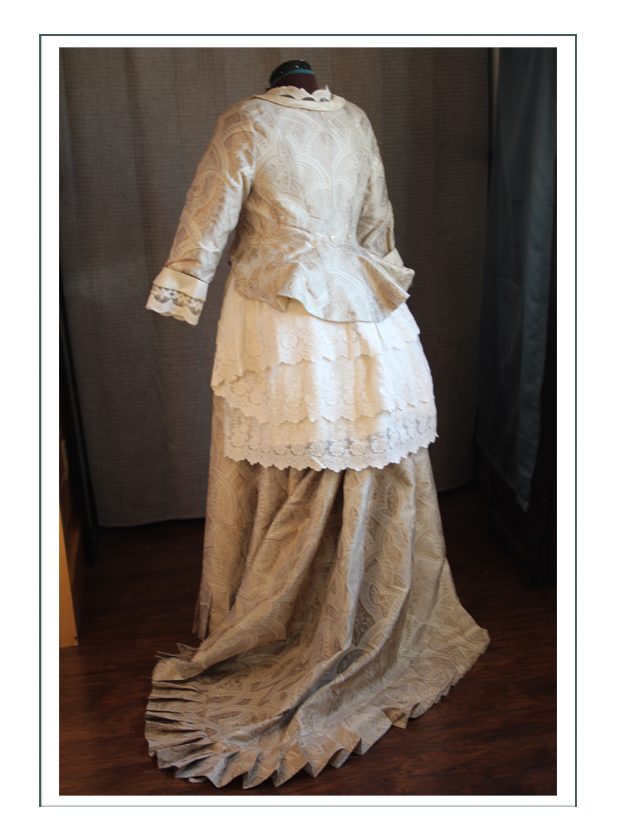
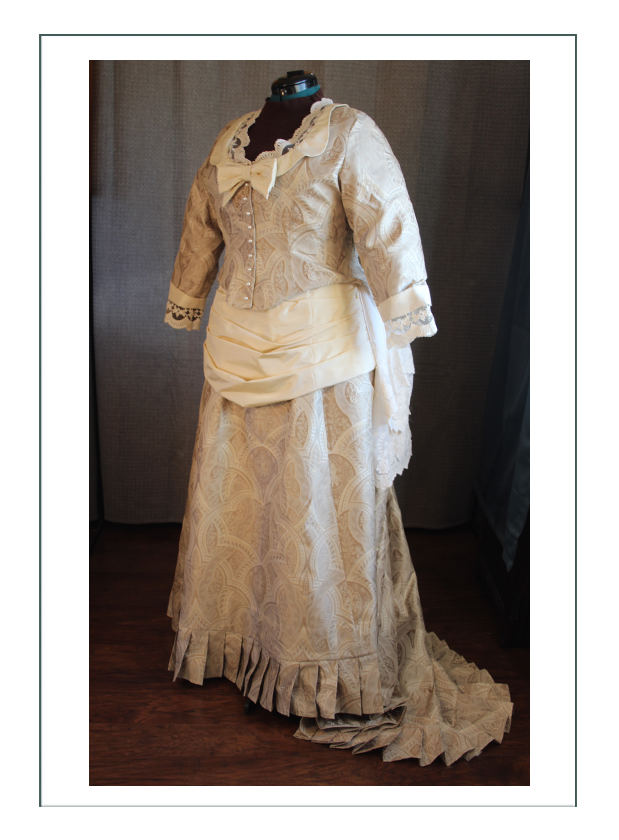
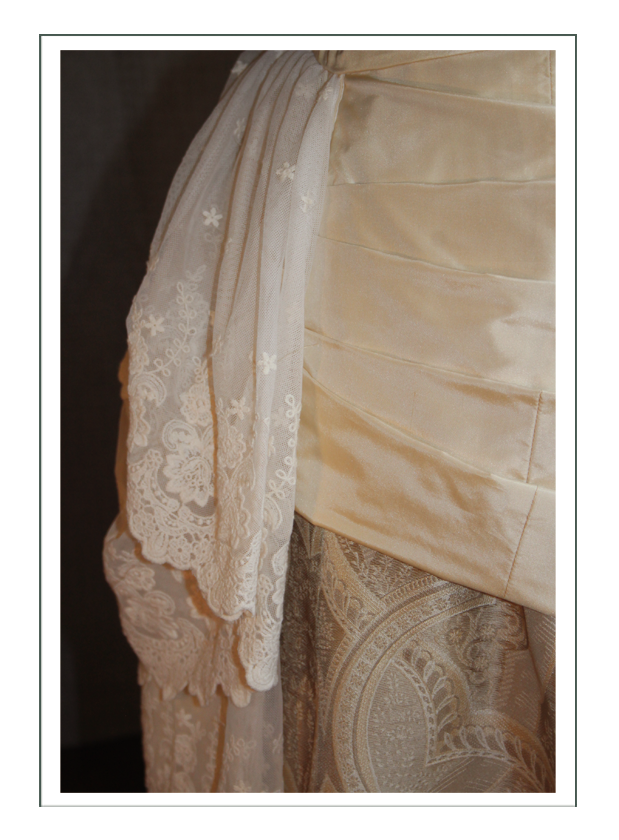
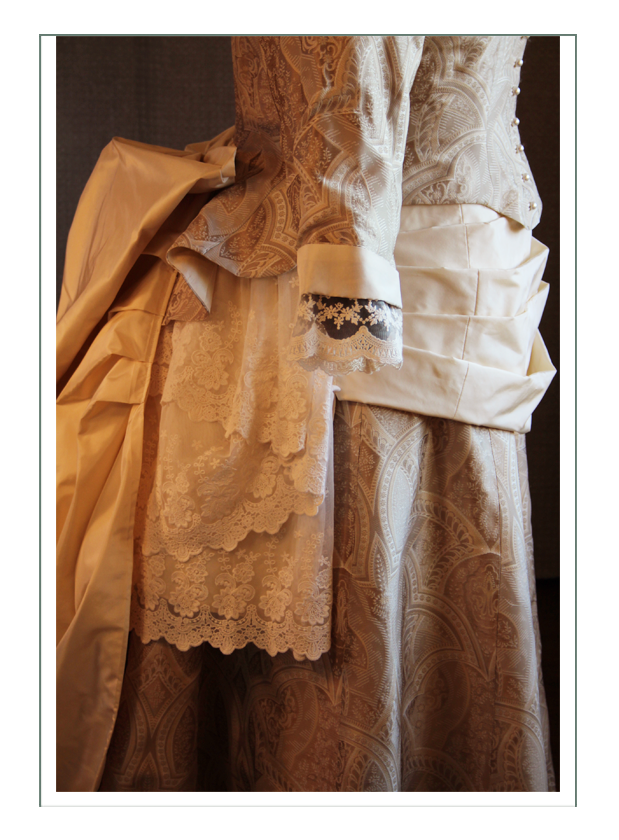
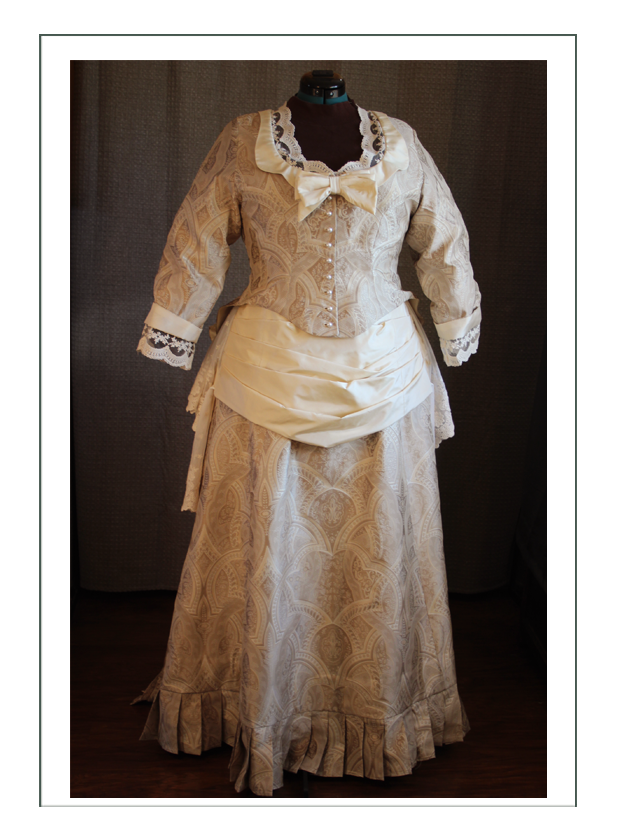
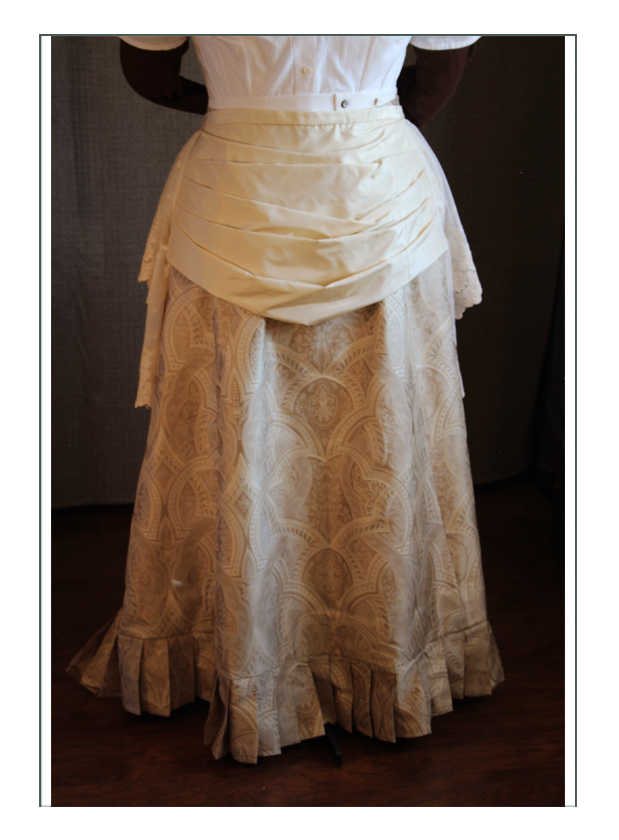

Butterfly Train Drape
This is made of the contrast taffeta. It was to have been of the main bodice fabric, but there was not enough fabric. It is a attachable to the buttons on the back of the bodice, and is completely lined and faced with taffeta silk too. All these fabrics are 100% silk (or 100% cotton for undergarments) so they are breathable, light, and easy to wear.
While this might have been tucked under the peplum of the bodice, we chose to feature the gorgeous buttons and interesting construction of the butterfly bow. This also allows it to be easily taken on or off during the wedding, leaving the apron drape for the reception.
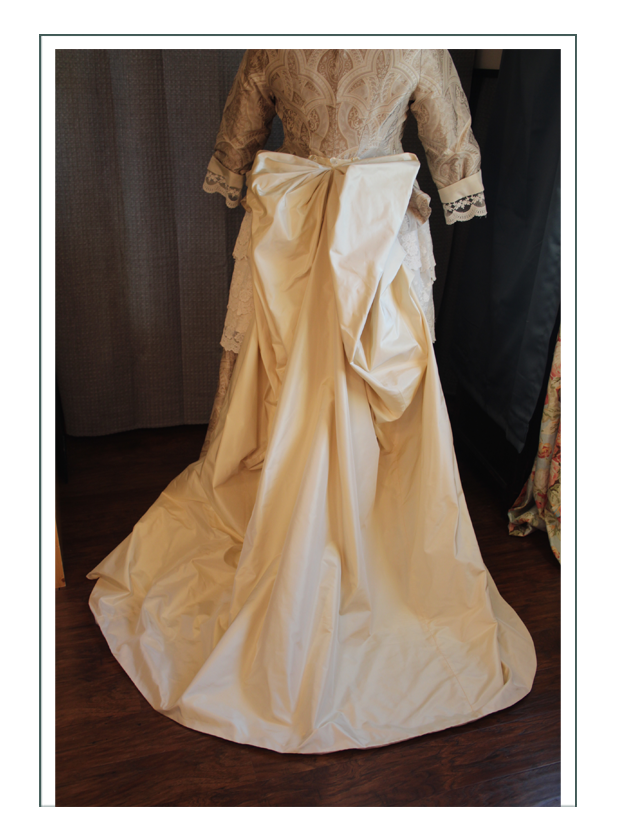
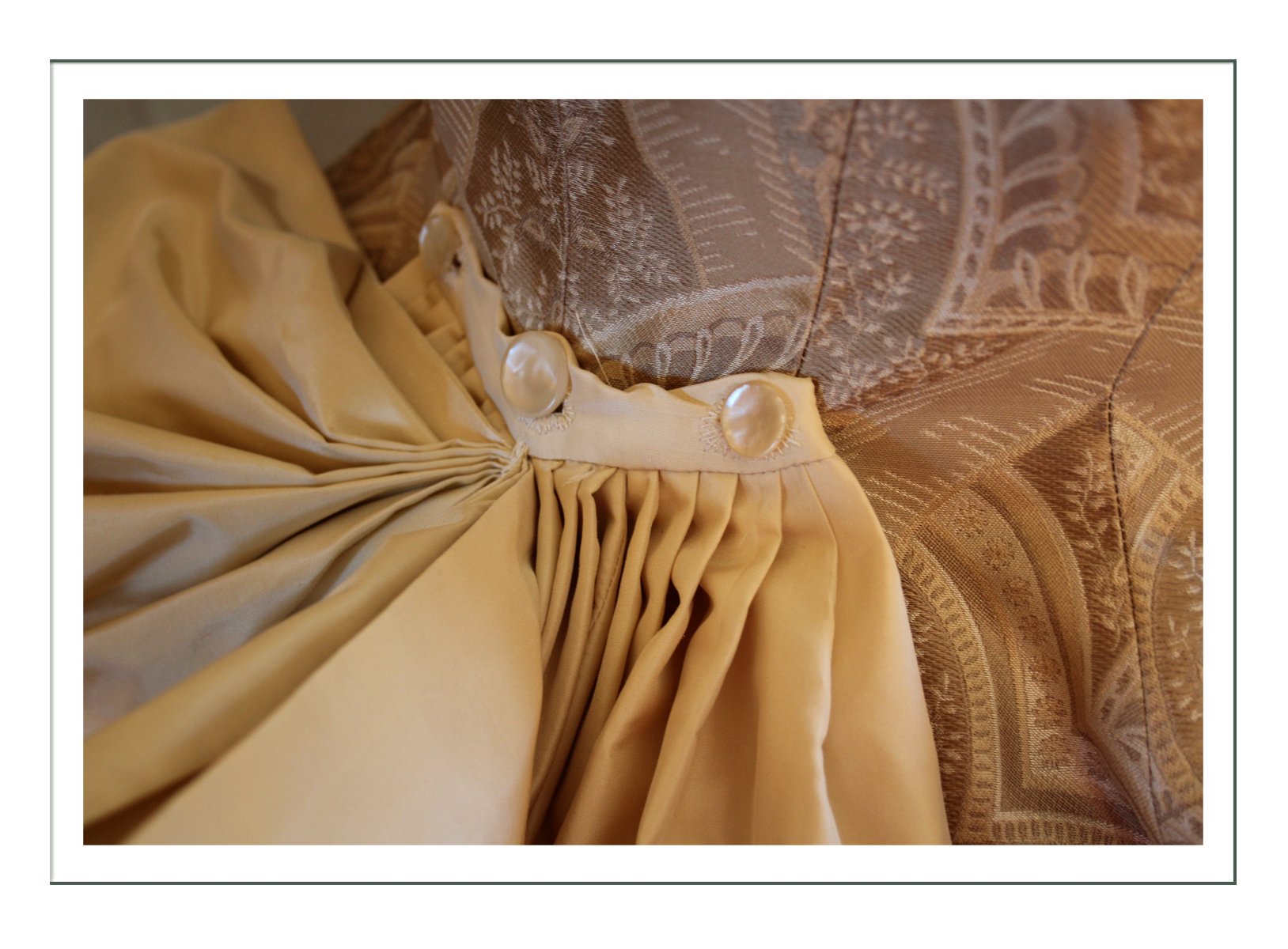
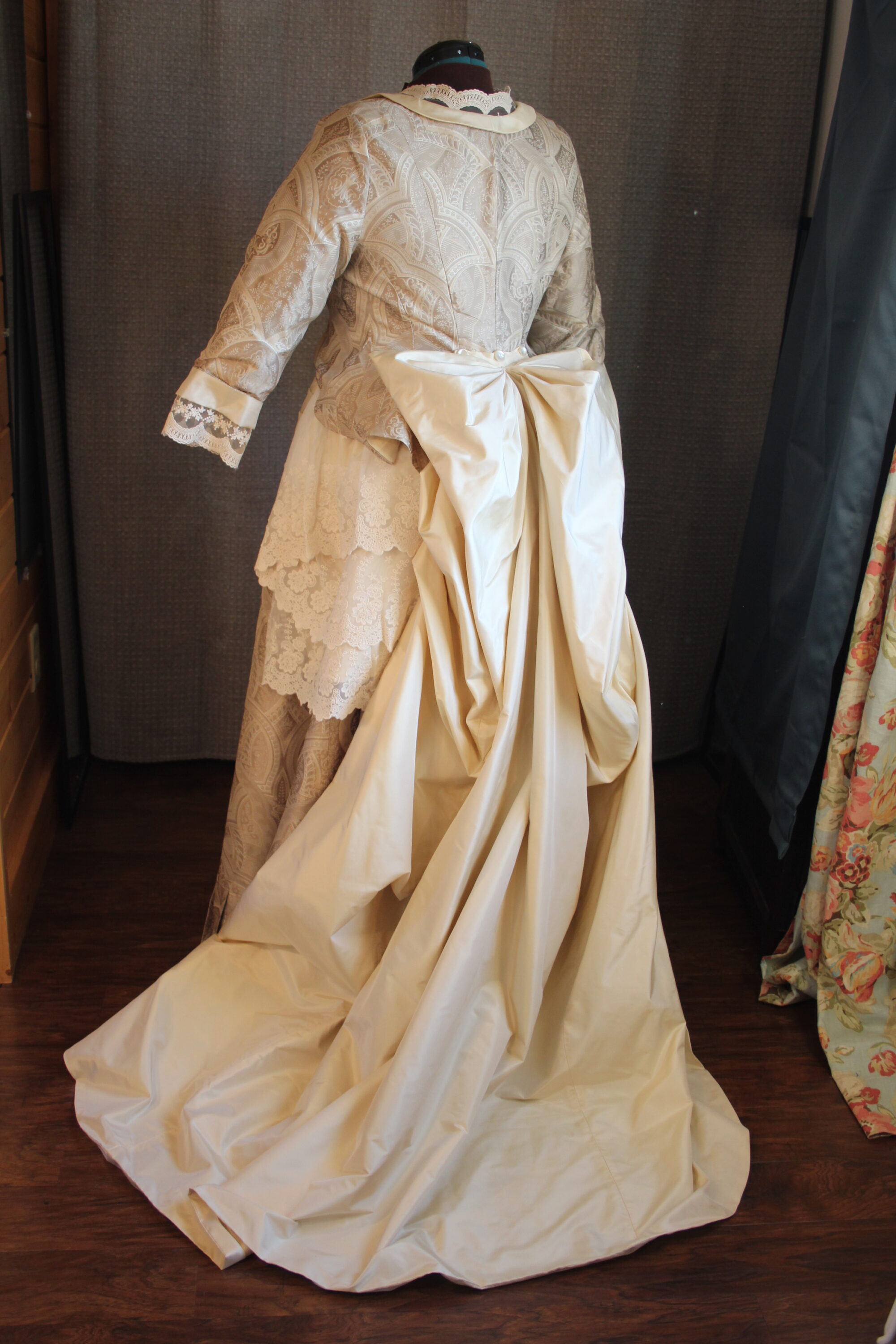
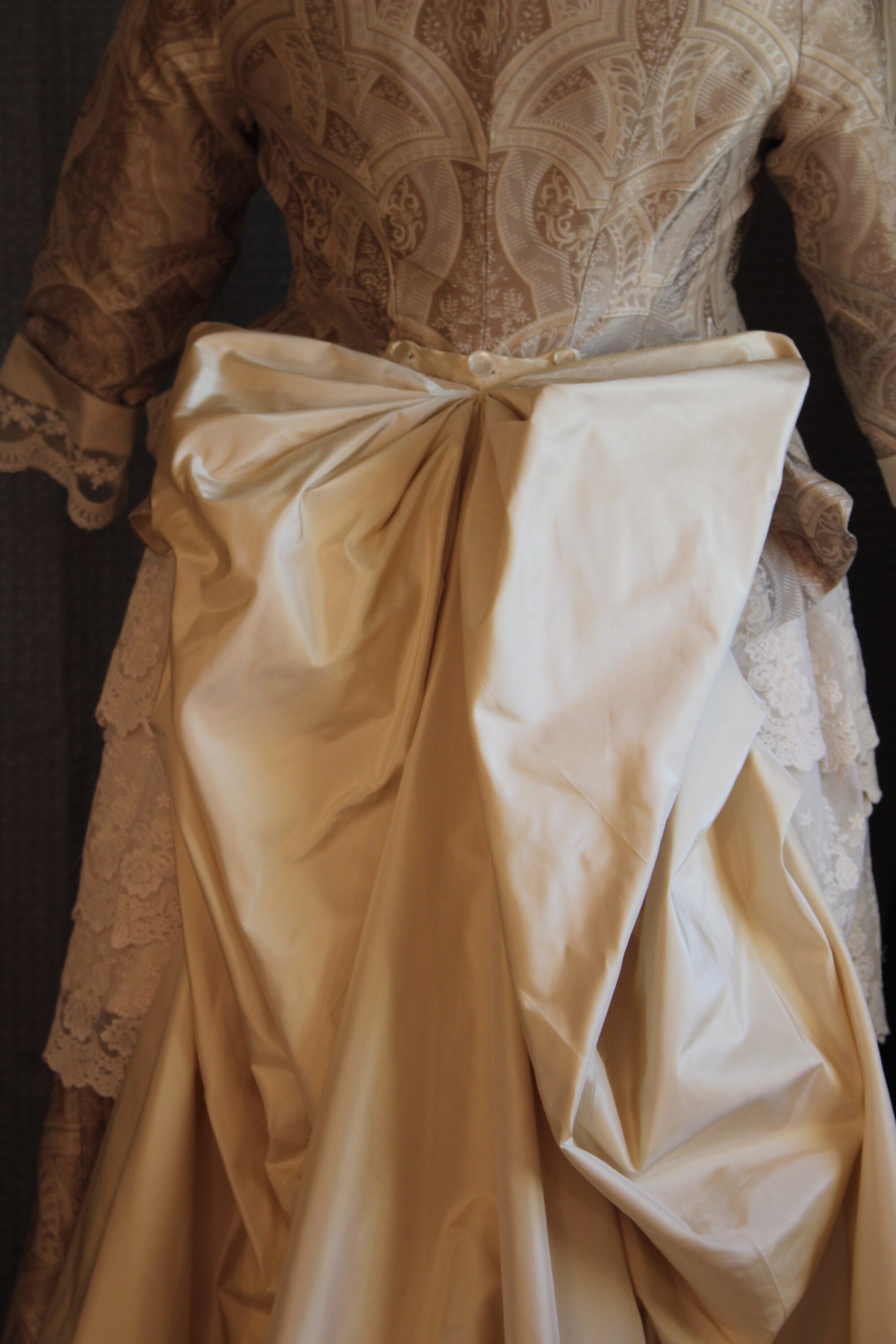
All Together!
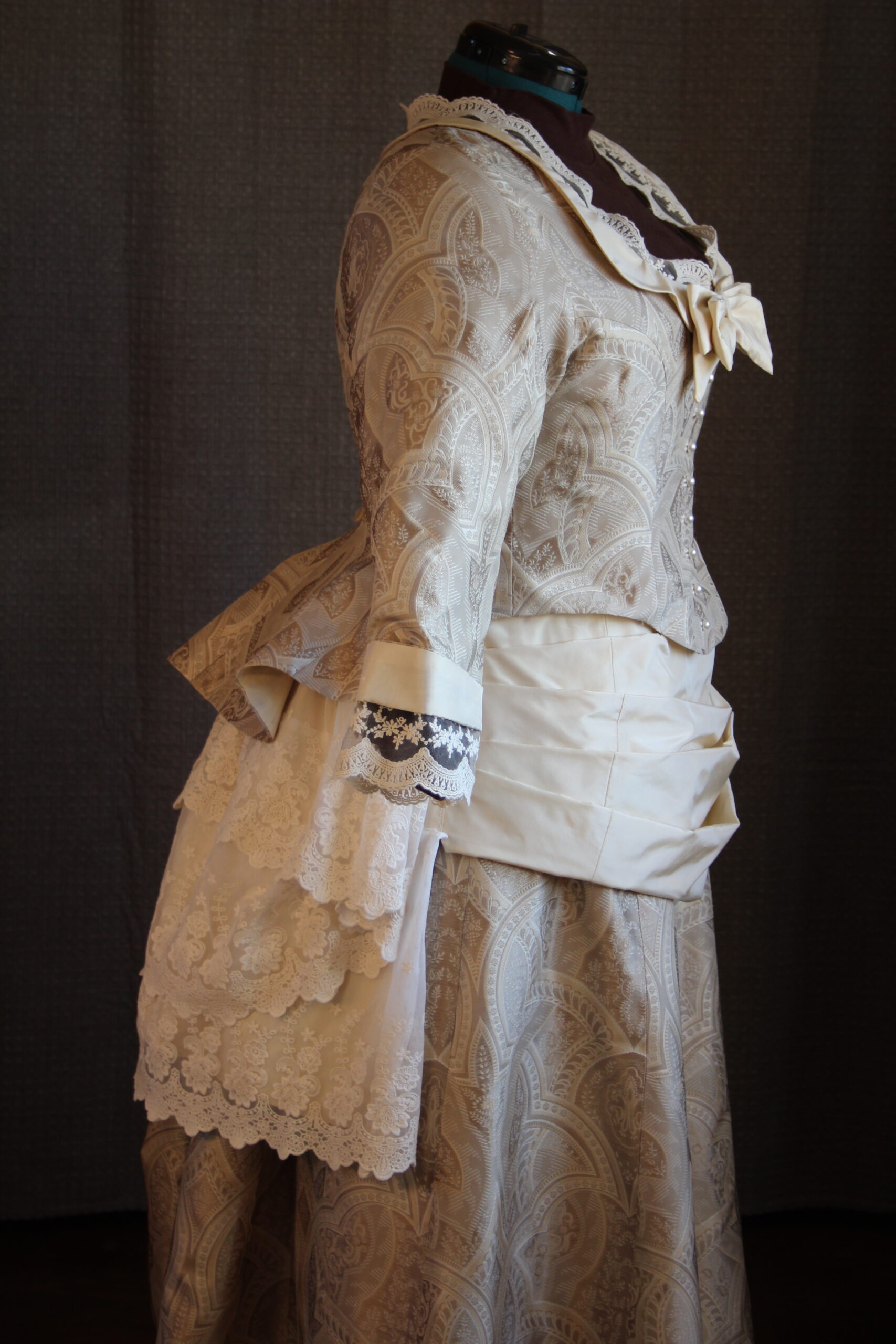
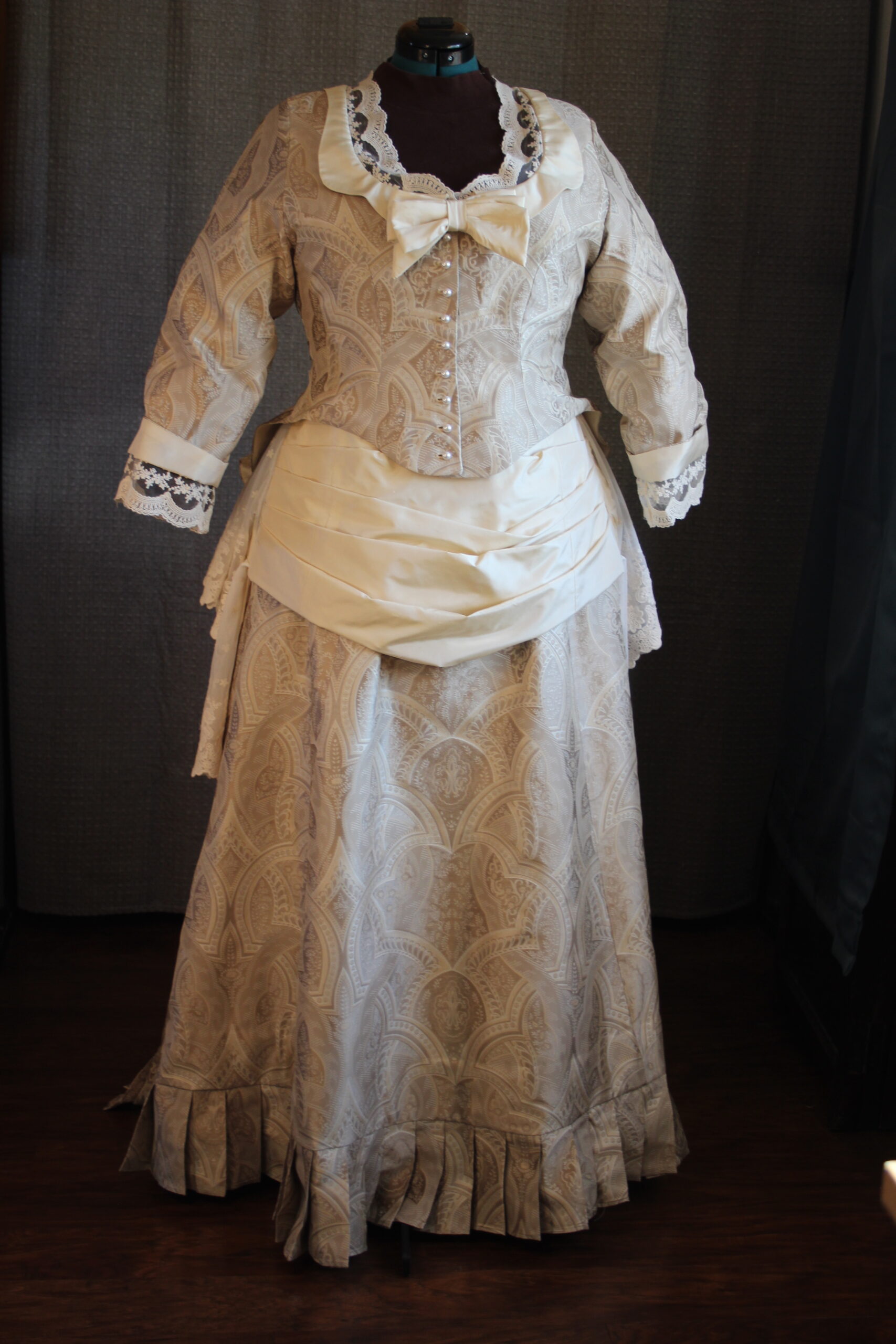
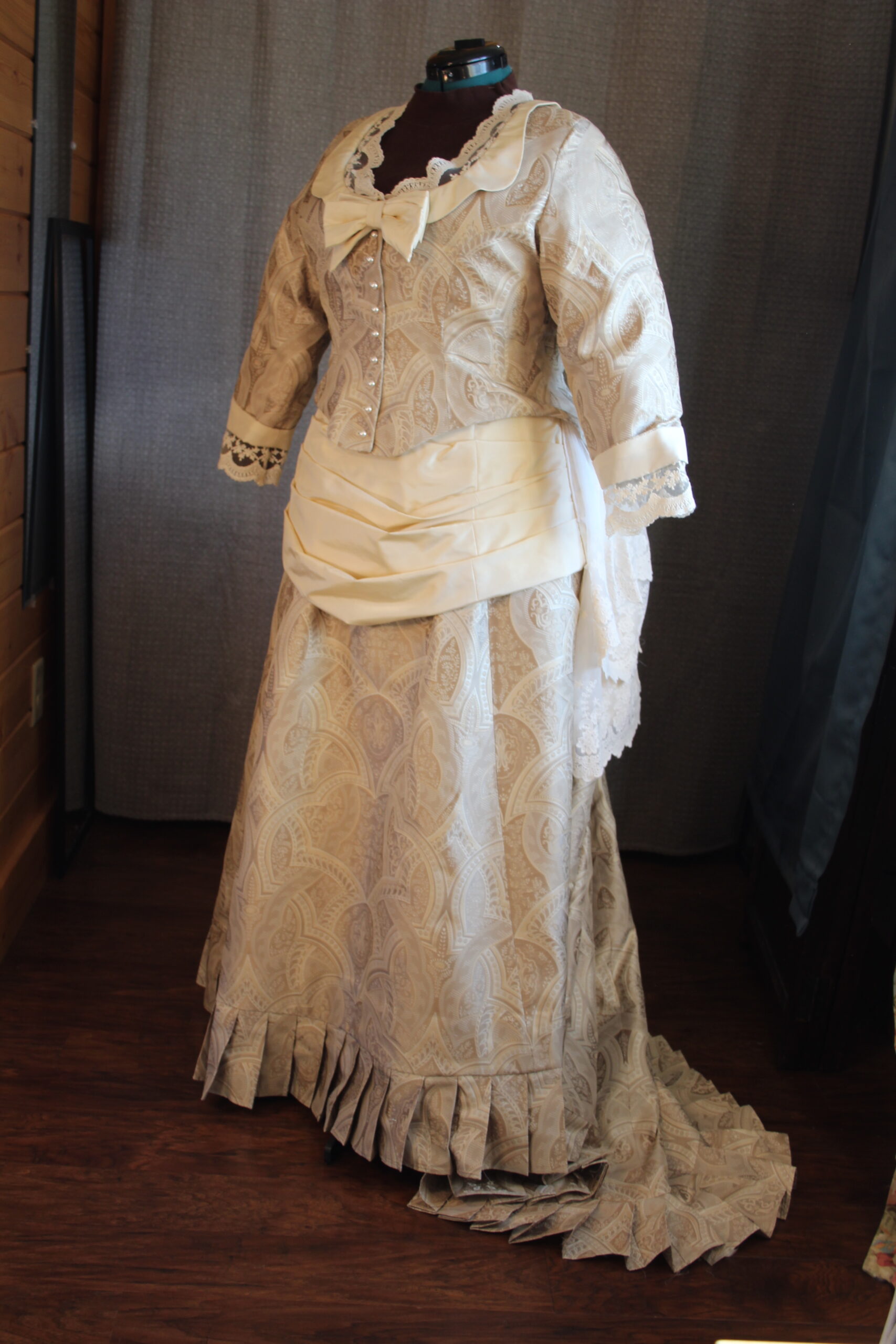
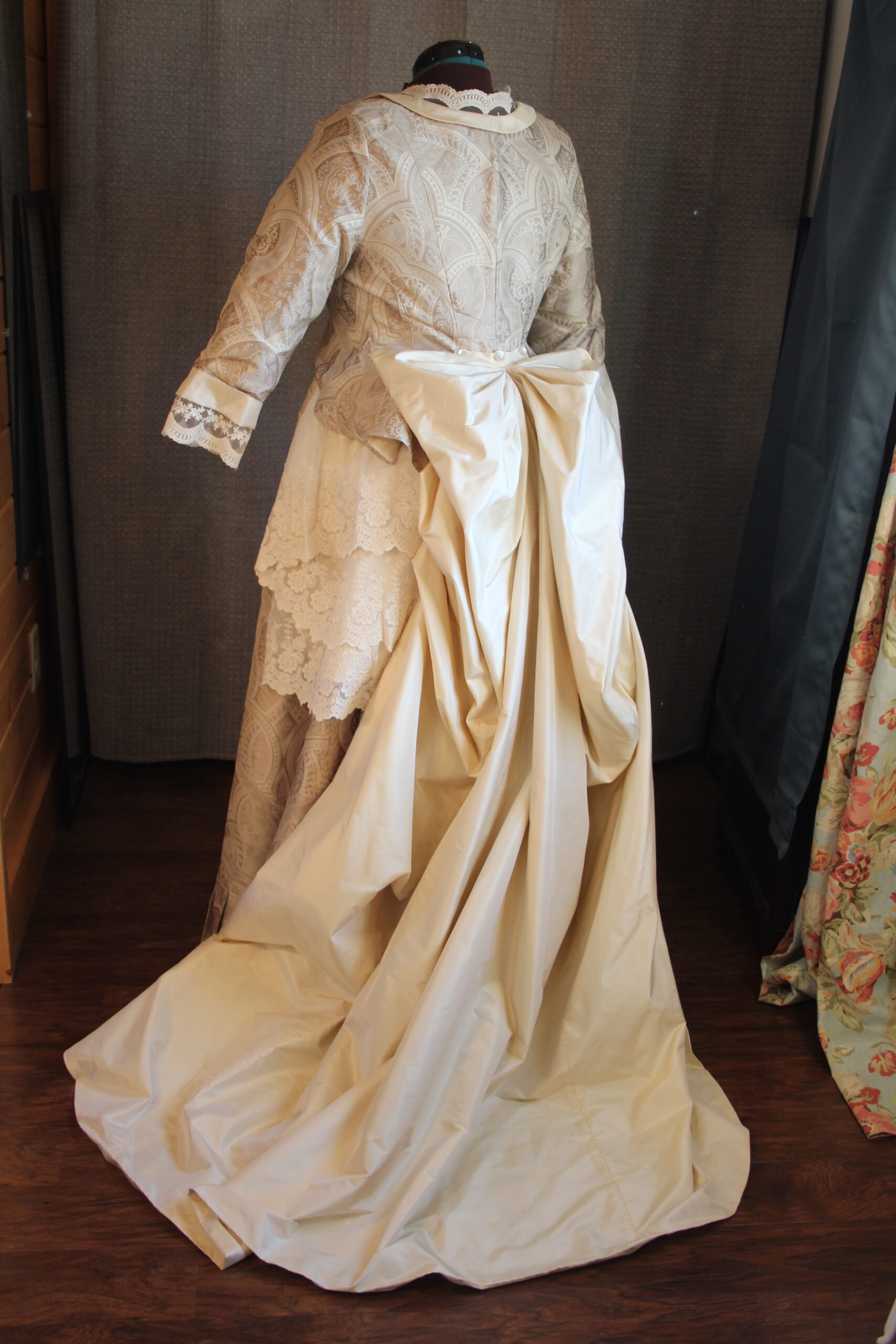
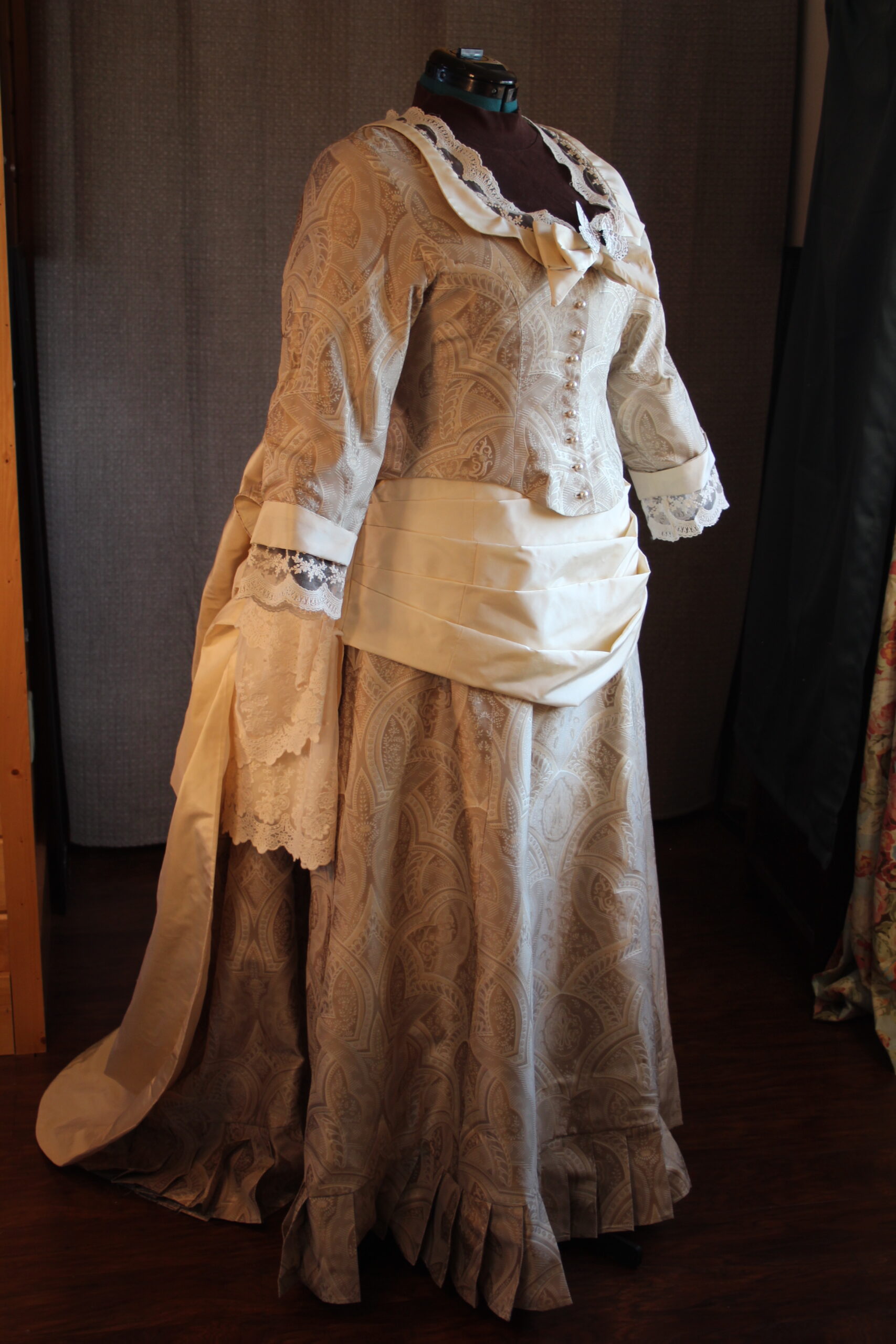
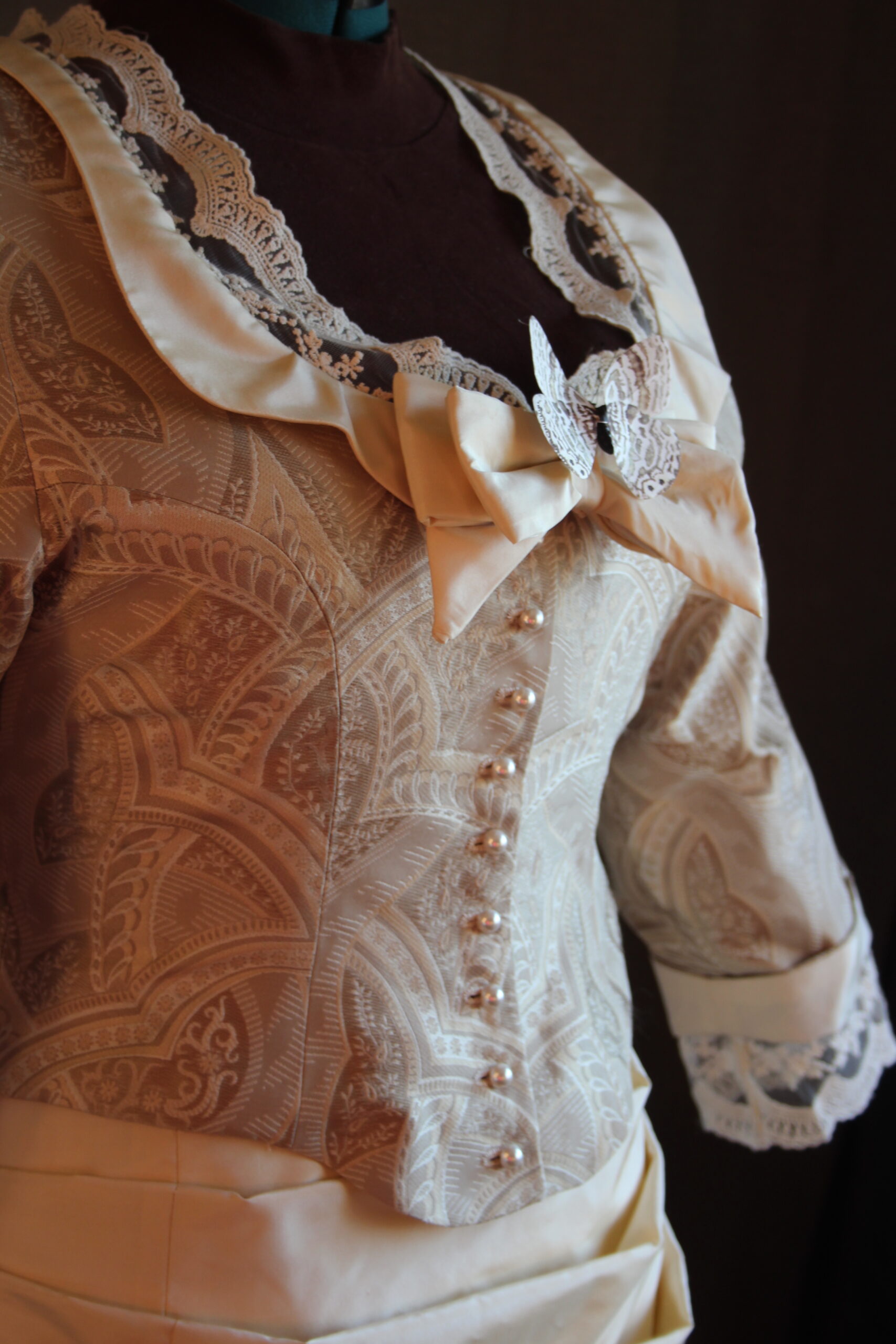

Rebecca provided Oak Tree Farm Boots and a high “Josephine” wig. We gave her some extra butterflies:
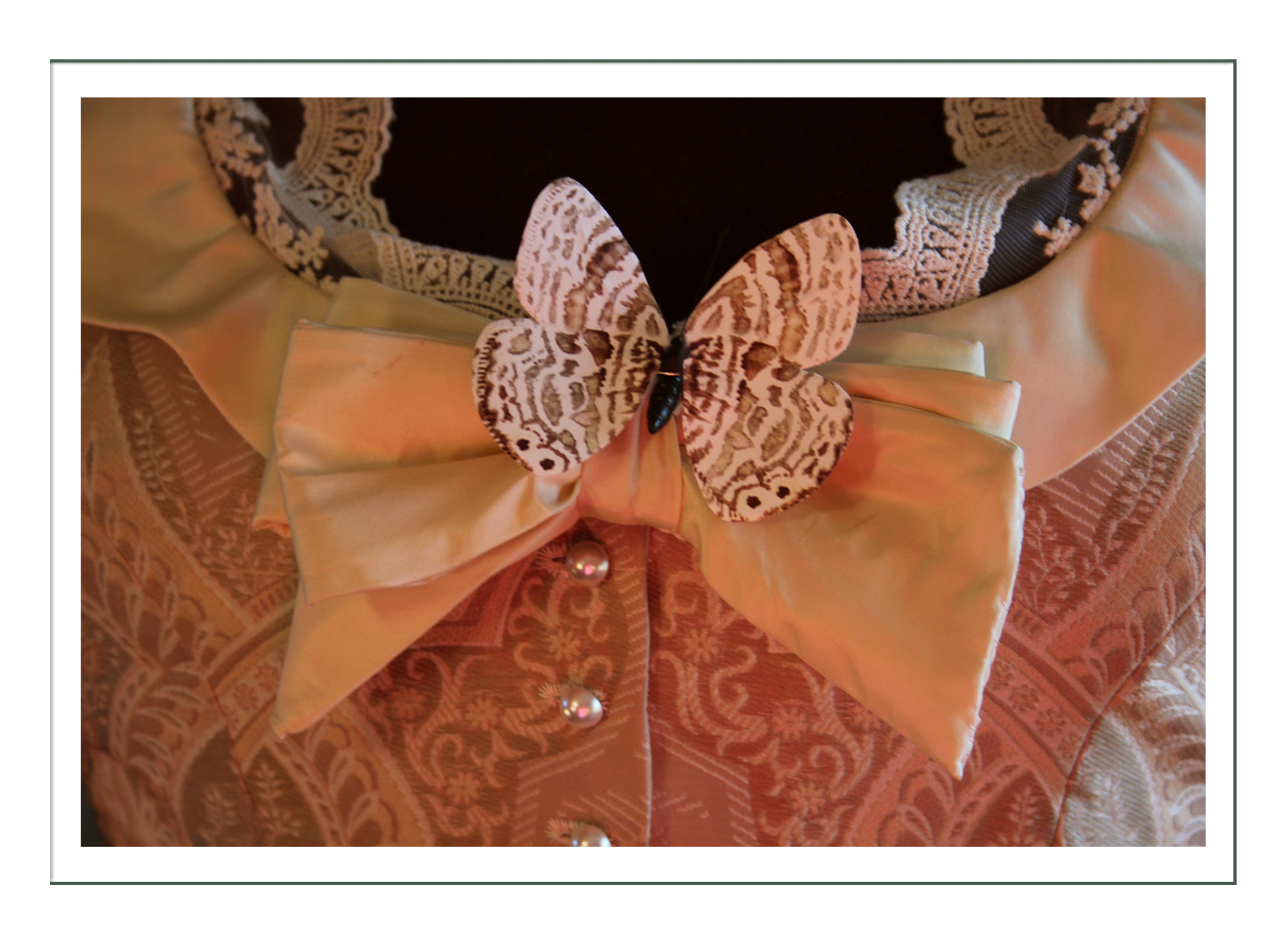

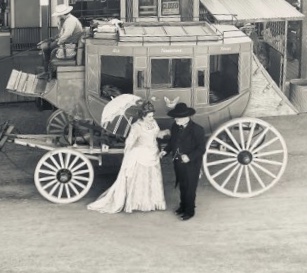
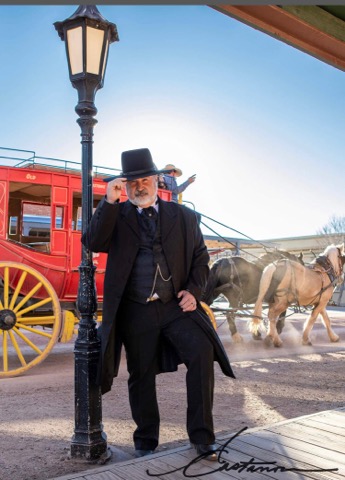
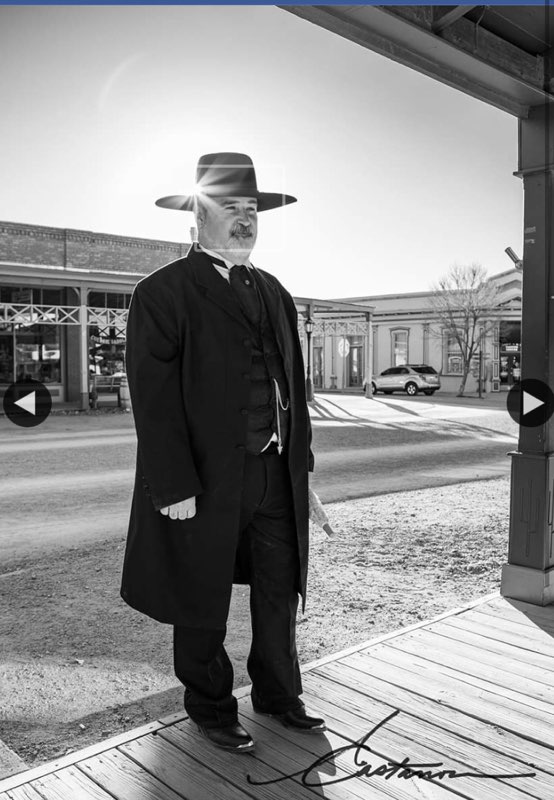
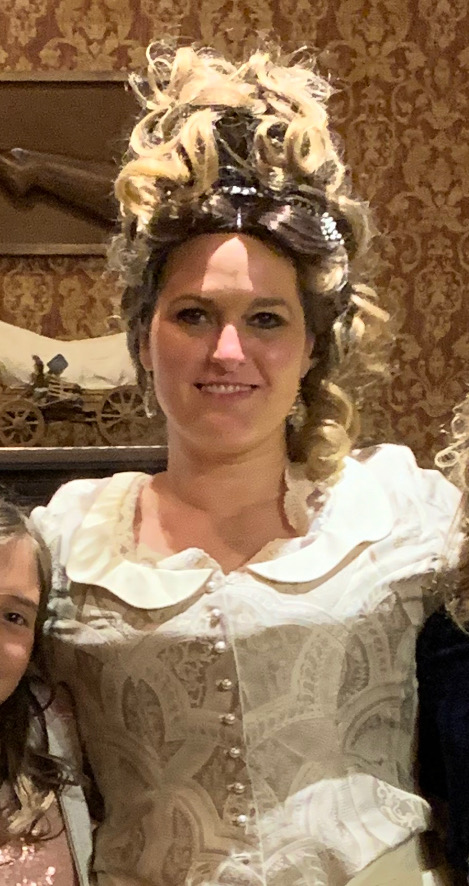

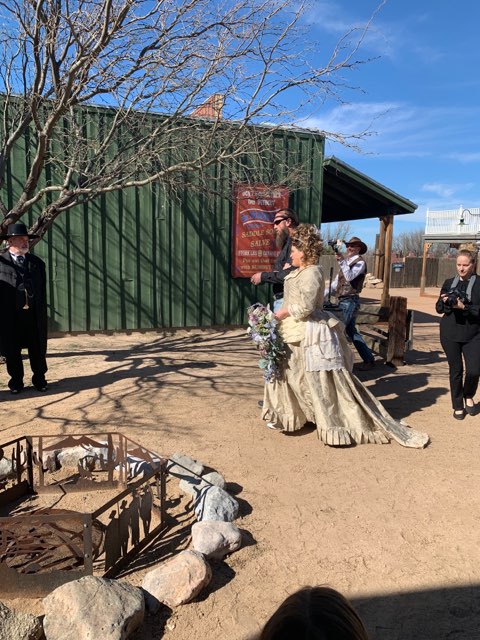

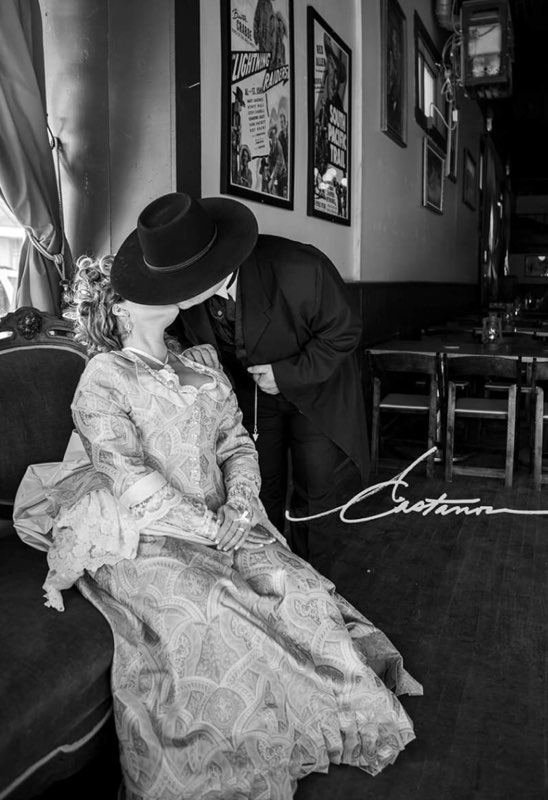
Click here to go to Rebecca’s Historical Context page (next)
Click here to go to the Fashion History pages including 1870’s vs 1880’s blog section
Click here to go to the Design Development page with Fabric selection
